ARCHIVED – Annual Report 2014 to Parliament
This page has been archived on the Web
Information identified as archived is provided for reference, research or recordkeeping purposes. It is not subject to the Government of Canada Web Standards and has not been altered or updated since it was archived. Please contact us to request a format other than those available.
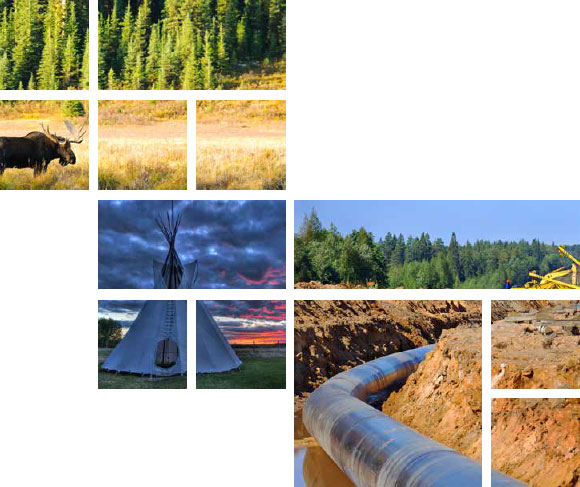
Annual Report 2014 to Parliament [PDF 3372 KB]
Copyright/Permission to Reproduce
ISSN 1498-5055

Chair’s Message
It was my honour to be appointed the role of Chair and CEO of the National Energy Board in June 2014. The Board also welcomed Lyne Mercier (Board Member) as the new Vice Chair in June.
In my first six months at the Board, I have seen firsthand the excellent work of our highly skilled staff. I have observed on numerous occasions that everyone here is dedicated and passionate about the work they do, a nd truly care about making a difference in protecting the interests of Canadians. Our staff feel personally responsible for helping to ensure the safety of Canada’s energy infrastructure. They share a passion for the public service, a commitment to fairness, taking responsibility and doing the right thing. This is certainly evident when you look at all that was accomplished over the course of 2014 namely the following:
- The launch of the Safety and Performance Dashboard in March provided us with the opportunity to be open with Canadians on key safety and environmental protection data collected by the Board. We understand that Canadians want to know more about how regulated companies perform, and sharing this type of information with the public supports our goal of being more transparent. Going forward we will ensure that even more of this type of information is always readily accessible.
- Also in March, the Board approved the Enbridge Line 9B Reversal and Line 9 Capacity Expansion Project. During the hearing participants brought forward a variety of valuable perspectives and information. As a result of this process, our approval was subject to conditions; conditions we imposed to protect the public and the environment. The project is in the public interest and Canadians can be confident that we take our oversight role seriously and, that we will never take public safety and environmental protection for granted.
- We issued the Hearing Order for the Trans Mountain Expansion project in April which started the NEB’s hearing process. This review is one of the most comprehensive in the NEB’s history. There are 400 intevenors, more than any previous hearing. We will hear from 1,260 commenters and more than 45 Aboriginal groups who have presented oral traditional evidence. We expect to submit our report in early 2016 to the federal government regarding whether this project should proceed. In October, TransCanada submitted their application for the Energy East Pipeline project, which is proposed to run from Alberta to New Brunswick. This review will examine the longest proposed pipeline project in the Board’s history. In addition to these projects, in total for 2014, we received nearly 600 applications for facilities, imports, exports, tolls and tariffs - making this a very busy year for the Board.
I believe that in order for the NEB to achieve our mandate and do the best job possible, we need to better understand what the public is thinking when it comes to pipeline safety and environmental protection. This is precisely why, in my opinion, there has never been a better time to engage with and listen to Canadians. So I was very pleased to announce in November that we would be launching a National Engagement Initiative in early 2015. Through discussions and meetings, we want to hear firsthand about how we can improve our approach to safety and environmental protection. We take our job as Canada’s national energy regulator seriously, including the need to continually improve.
This is the beginning of a new era for the Board. While I am confident in the strong regulatory regime we have in place, there is always room to get better. You have my commitment that energy regulation at the NEB will continue to be world class and, that we will learn and adapt, as required, to keep it that way.
Original signed by
Peter Watson, Chair and CEO

Who We Are and What We Do
The National Energy Board is Canada’s energy and safety regulator. We do not simply make a decision on a project and then walk away. We oversee safety for the full lifecycle of energy facilities — from approval to construction to operation to abandonment. We work alongside communities and share the same goal of making energy infrastructure the very safest it can be.
The staff of the National Energy Board is made up of highly skilled employees including: engineers, environmental specialists, auditors, inspectors, engagement staff, legal and administrative specialists, and others. We are proud of the work we do protecting the interests of Canadians. Whether it’s managing public hearings, building a better Web site, recruiting talented new employees or walking pipelines conducting inspections - we know our work makes a difference in keeping energy infrastructure safe and reliable.
In order for the Board to effectively serve the Canadian public, we know they need to have confidence in the regulatory regime and believe in the Board’s ability to enforce the orders, rules and regulations that are in place to protect Canadians, their communities and their environment.
Our work goes beyond approving projects and penalizing those who don’t follow our rules. We are here to serve the Public. We want to make certain that Canadians know they have a regulator they can rely on, because the Canadian Public interest is at the heart of everything we do.
In order to achieve our core mandate, the Board has outlined three strategic priorities where we will:
- continue to strategically develop, refine and communicate our actions on pipeline safety and environmental protection;
- continue to focus on safety outcomes supported by a more strategic approach to engaging with Canadians; and;
- develop and implement a framework for regulatory excellence.
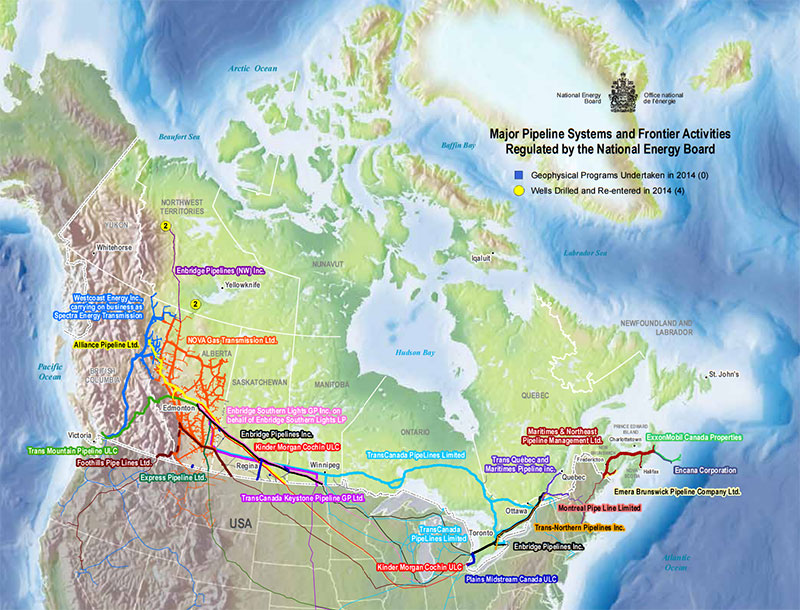
View a larger version of this map [PDF 412 KB]
The Board
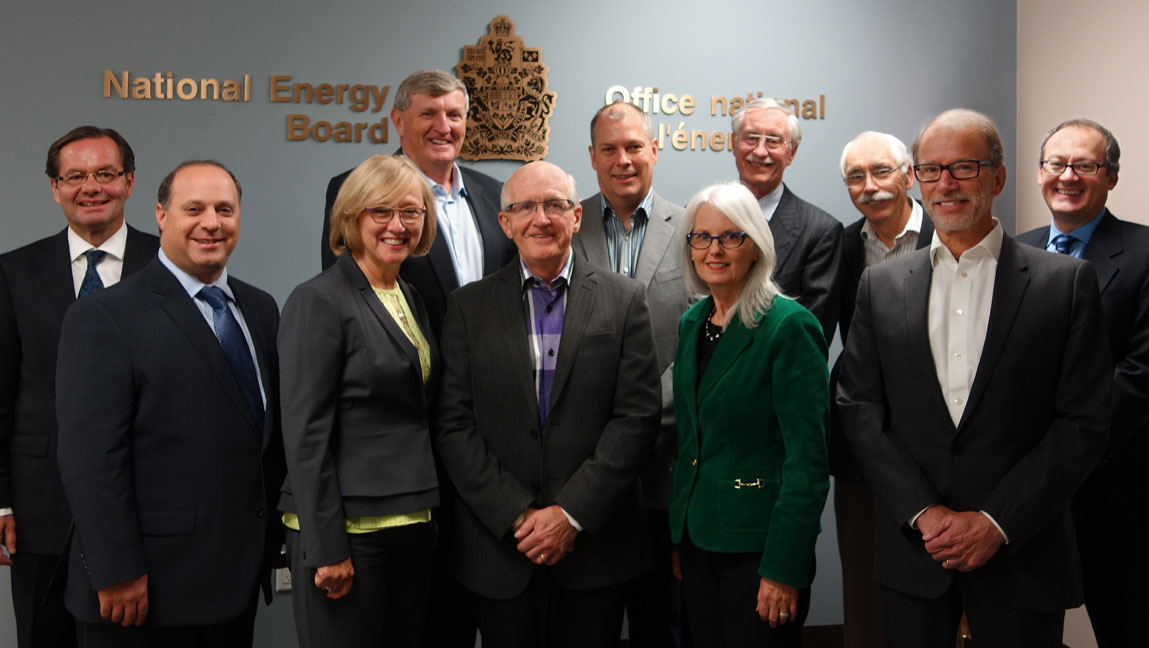
Back (left to right): Jacques Gauthier, James Ballem, Peter Watson, Ron Wallace, Bob Vergette and Shane Parrish
Front (left to right): Mike Richmond, Allison Scott, David Hamilton, Lyne Mercier, and Phil Davies
Absent: Roland George and Kenneth Bateman

Our Role and Responsibilities
The National Energy Board (NEB or Board) is an independent federal regulator established in 1959. Our mandate is to promote safety and security, environmental protection and economic efficiency in the Canadian public interest, in the regulation of pipelines, energy development and trade. The Board reports to Parliament through the Minister of Natural Resources.
In 2014, the NEB-regulated approximately 73,000 kilometres of interprovincial and international pipelines along with approximately 1,400 kilometres of international power lines across Canada.
The pipelines, owned by 101 companies, shipped approximately $159 billion worth of crude oil, petroleum products, natural gas liquids and natural gas to Canadians and export customers at an estimated transportation cost of $7 billion. Overall, 31 companies had ownership of NEB-regulated international power lines which transmitted approximately $3.6 billion of electricity into and out of Canada.
The main responsibilities of the NEB are established in the National Energy Board Act (NEB Act). More information on the background and operations of the NEB can be found on the Board’s website, www.neb-one.gc.ca.
Full Cycle Regulation
The Board regulates Canada’s federal energy infrastructure over its complete life-cycle. During the design phase of the project we review and impose conditions. When they are being built, we inspect. When they are being operated, we audit. And when a pipeline has reached the end of its usefulness, we review abandonment applications to ensure that it is abandoned in a safe and environmentally responsible manner.
In other words, the Board regulates from “start to finish”, and holds pipeline companies responsible for the full life-cycle of the pipelines they operate.
We also require the companies we regulate to anticipate, prevent, manage, and mitigate any potentially dangerous conditions associated with their activities. Our Board Members and staff will not hesitate to use our full enforcement toolkit to achieve compliance with rules and regulations protecting safety and the environment.
Energy Infrastructure - Today and Tomorrow
Canadians depend on the pipeline transportation system for safe, reliable and efficient energy supply, now and in the future. The ability of this system to safely deliver natural gas, natural gas liquids (NGLs), crude oil, and petroleum products is also critical to Canada’s economy. The NEB is active and effective in Canada’s pursuit of a sustainable energy future by integrating relevant economic, environmental and social considerations when choosing a course of action.
Our requirements encourage innovation where possible but also specify mandatory design, operational practices or management methods when necessary. The regulatory framework supports a sustainable energy system that will meet Canadians’ needs today, while taking into consideration the needs of Canadians tomorrow.
Applications in 2014
Companies regulated by the NEB are required to seek the Board’s approval to, among other things:
- construct and operate international and interprovincial pipelines and international power lines in Canada, along with related facilities and activities, or modify or abandon existing facilities;
- export crude oil, natural gas liquids and electricity, and export and import natural gas; and
- establish pipeline tolls and tariffs.
| 2013 | 2014 | |
| Section 52 certificates | 3 | 4 |
| Section 58 orders | 41 | 44 |
| Part VI Import/Export | 412 | 511 |
| Traffic, Tolls and Tariffs | 18 | 15 |
| Abandonment | 5 | 2 |
Decisions and Recommendations Issued in 2014 Include the Following:
Facilities
Edmonton to Hardisty Pipeline Project
On 30 January 2014, the Board recommended that Governor in Council (GiC) approve the issuance of a Certificate of Public Convenience and Necessity (Certificate) to Enbridge Pipelines Inc. (Enbridge) for the construction and operation of a new 182 km pipeline from Enbridge’s existing Edmonton Terminal to its existing Hardisty Terminal in Alberta, subject to 17 conditions.
The Project would also include construction of a new initiating pump station at the Edmonton Terminal, a new pump station at each of Enbridge’s existing Strome and Kingman stations, and associated facilities and infrastructure at the Edmonton and Hardisty Terminals. The Board approved these additional facilities, subject to 14 conditions. The Order approving the additional facilities will take effect only if the Certificate is issued. The Board also approved Enbridge’s proposed tolling methodology for the Project, subject to the Certificate being issued. Please see the NEB’s website to read the complete recommendation and decision. (OH-001-2013)
Abandonment of the North Reagan Pipeline
On 6 May 2014, the Board granted Glencoe Resources Ltd. leave to abandon in-place the approximately 215-metre North Reagan Pipeline and associated surface equipment (Pipeline), subject to eight conditions. About 200 metres of the Pipeline are located within Canada and 15 metres are within the United States. Please see the NEB’s website to read the complete decision. (MHW-001-2014)
Integration Asset Transfer
On 16 October 2014, the Board approved an application from Nova Gas Transmission Ltd. (NGTL) to sell certain assets to ATCO Gas and Pipelines Limited (NGTL Transferred Assets), and granted NGTL leave to purchase certain assets from ATCO Gas and Pipelines Ltd. (ATCO Transferred Assets). The NGTL Transferred Assets are comprised of 31 delivery and 89 receipt meter stations and 1,418 km of pipeline. The ATCO Transferred Assets are comprised of 11 delivery and 19 receipt meter stations, one compressor station and 1,249 km of pipeline. The Board also recommended that GiC approve the issuance of a Certificate for the ATCO Transferred Assets that would come into the Board’s jurisdiction as well as the variation of an existing Certificate to reflect the NGTL Transferred Assets leaving the Board’s jurisdiction. The Board granted NGTL leave to open the facilities, and approved NGTL’s proposed Monetary and NonMonetary Adjustments, should a Certificate be issued. Please see the NEB’s website to read the complete recommendation and decision. (GH-002-2014)

Tolls and Tariffs
TransCanada PipeLines Ltd. 2015 to 2030 Tolls
On 28 November 2014, the Board approved revised tolls and tariff for TransCanada PipeLines Ltd.’s Mainline System. Reasons for Decision were issued on 18 December 2014. TransCanada applied for approval of a settlement agreement (Settlement) for its Mainline System. The Settlement was reached between TransCanada and three Canadian local distribution companies - Enbridge Gas Distribution Inc., Union Gas Ltd. and Gaz Métro Limited Partnership. After a comment process among TransCanada shippers and stakeholders, the Board found it could not approve the Settlement as a contested settlement under the Board’s Settlement Guidelines. In April 2014, TransCanada agreed to the Board’s offer to treat the Settlement as a contested tolls application. The Board approved the applied-for design for Mainline tolls for 2015 to 2020. In principle, the Board approved certain parameters for a toll-setting methodology up to 2030. The Board decided to maintain pricing discretion established in the RH-003-2011 Decision but directed TransCanada to provide remedies preventing access to and the use of non-public, shipper-specific information in its exercise of pricing discretion. The Board directed TransCanada to file an application prior to 31 December 2017 to review the ongoing appropriateness of the approved toll design for the 2018 to 2020 period. Please see the NEB’s website to read the complete decision. (RH-001-2014)
Part VI - Imports and Exports
Jordan Cove LNG Export License
On 20 February 2014, the Board approved an application by Jordan Cove LNG for a license to export liquefied natural gas (LNG), subject to GiC approval. Following a written process, the Board determined that the quantity of gas proposed to be exported by Jordan Cove LNG is surplus to Canadian needs. Jordan Cove LNG’s request for exemption from the Reporting Regulations was denied; however, the Board accepted Jordan Cove LNG’s request for a 15 per cent annual tolerance and a 10-year sunset clause. The export license authorizes Jordan Cove LNG to export 442.68 billion cubic metres (109m³) over a 25-year term. LNG will be exported from Canada at the natural gas pipeline export points near Kingsgate and Huntingdon, British Columbia. Please see the NEB’s website to read the complete decision. (OF-EI-Gas-GL-J705-2013-01 01)
Triton LNG Limited Partnership Export License
On 16 April 2014, the Board approved an application by Triton LNG LP to export LNG, subject to GIC approval. The Board determined that the quantity of gas proposed to be exported by Triton LNG LP is surplus to Canadian needs. Triton LNG LP’s request for exemption from the Reporting Regulations was denied; however, the Board accepted Triton LNG’s request for a 15 per cent annual tolerance and a 10-year sunset clause. The export license authorizes Triton LNG to export 93.725 billion cubic metres (109m³) over a 25-year term. LNG will be exported from Canada at the outlet of the loading arm of a proposed natural gas liquefaction terminal to be located in the vicinity of Kitimat or Prince Rupert, British Columbia. Please see the NEB’s website to read the complete decision. (OF-EI-GasGL-T293-2013-01 01)
Oregon LNG Marketing Company, LLC Export License
On 1 May 2014, the Board approved an application by Oregon LNG Marketing Company, LLC (Oregon LNG) to export LNG, subject to GiC approval. The Board determined that the quantity of gas proposed to be exported by Oregon LNG is surplus to Canadian needs. The Board accepted Oregon LNG’s request for a 15 per cent annual tolerance and a 10-year sunset clause. The export license authorizes Oregon LNG to export 375.17 billion cubic metres (109m³) over a 25-year term. LNG will be exported from Canada at the natural gas pipeline export points near Kingsgate and Huntingdon, British Columbia. Please see the NEB’s website to read the complete decision. (OF-EI-Gas-GL-O113-2014-01 01)
Aurora LNG Ltd. Export License
On 1 May 2014, the Board approved an application by Aurora LNG Ltd. to export LNG, subject to GiC approval. The Board determined that the quantity of gas proposed to be exported by Aurora LNG is surplus to Canadian needs. The Board accepted Aurora LNG’s request for a 15 per cent annual tolerance and a 10-year sunset clause. The export license authorizes Aurora LNG to export 849.82 billion cubic metres (109m³) over a 25-year term. LNG will be exported from Canada at the outlet of the loading arm of a proposed natural gas liquefaction terminal to be located in the vicinity of Prince Rupert, British Columbia. Please see the NEB’s website to read the complete decision. (OF-EI-Gas-GL-A777-2013-01 01)

Service Standards and Results in 2014
Service standards are an essential tool in today’s resultsbased management environment. The NEB has its own internal service standards for many regulatory functions and services.
The Board communicates to the public and stakeholders the expected timeline in which an application or request will be processed, having due regard to the assessment it must carry out to fulfill the NEB’s mandate as stipulated in the legislation.
The following tables 1, 2 and 3 list the overall NEB service standards and results, as well as the standards and results for electricity export applications and section 58 applications in 2014.
Table 1 - NEB Service Standards and Results in 2014
| Task | Service Standard | No. of Applications or Requests | Results |
|---|---|---|---|
| Release of Hearing Decisions and Recommendations | 100 % of Reasons for Decision or Recommendation for applications under s.52, 58 or 58.16 completed no later than 15 months from the Board’s determination. | 3 | 100% |
| Release of Hearing Decisions and Recommendations | 80% of Reasons for Decision or Recommendations for applications other than s.52, 58 or 58.16 completed within 12 weeks following a public hearing. | 5 | 100% |
| COGO Act Applications to drill a well | Decision rendered within 21 calendar days of the receipt of a complete application | 0 | n/a |
| COGO Act Applications to alter the condition of a well | Decision rendered within 21 calendar days of the receipt of a complete application | 4 | 100% |
| COGO Act Geological and Geophysical Applications | Decision rendered within 30 calendar days of the receipt of a complete application | 3 | 100% |
| Authorization for export of crude oil and/or petroleum products | Two working days (short-term orders only) | 36 | 100% |
| Authorization for export and import of natural gas | Two working days (short-term orders only) | 232 | 99% |
| Authorization for export of NGLs | Two working days (short-term orders only) | 14 | 100% |
| CPR Act Applications Significant Discovery Applications on frontier lands |
80% of decisions rendered within 90 calendar daysfrom the day that all information is available to begin the evaluation process | 0 | n/a |
| CPR Act Applications Commercial Discovery Applications on frontier lands |
80% of decisions made within 90 calendar days from the day that all information is available to begin the evaluation process | 0 | n/a |
| Landowner Complaint Process | 100% of requests responded to within 10 calendar days | 19 | 100% |
| Financial Audits | 80% of draft audit reports will be sent to the company within eight weeks of field work completion | 2 | 100% |
Table 2 - Service Standards and Results for Electricity Export Applications in 2014
| Category | Category Description | Service Standard | No. of Applications | Results |
|---|---|---|---|---|
| A | Minor complexity of issues | 80% of decisions released within 40 calendar days following the completion of the Notice of Application period | 9 | 100% |
| B | Moderate complexity of issues | 80% of decisions released within 90 calendar days following the completion of the Notice of Application period | 0 | n/a |
Table 3 - Service Standards and Results for Section 58 Applications in 2014
| Category | Category Description | Service Standard | No. of Applications | Results |
|---|---|---|---|---|
| A | Minor complexity of issues with no third party interest | 80% completed within 40 calendar days of the receipt of a complete application | 8 | 100% |
| B | Moderate complexity of issues with possible third party interest | 80% completed within 90 calendar days of the receipt of a complete application | 25 | 96% |
| C | Major complexity of issues with likely third party interest | 80% completed within 120 calendar days of the receipt of a complete application | 6 | 83% |
In the Public Interest
The NEB regulates pipelines, energy development and trade in the Canadian public interest. The public interest is inclusive of all Canadians and refers to a balance of economic, environmental and social considerations that changes as society’s values and preferences evolve over time.
A key component of this process is listening to what Canadians have to say about how energy infrastructure is developed and regulated, engaging them in meaningful dialogue about issues and solutions, and publically sharing information about regulatory initiatives.
NEB Engagement
| Engagement Type | 2011 | 2012 | 2013 | 2014 |
|---|---|---|---|---|
| Application specific | 56 | 23 | 45 | 135 |
| Non-application specific | 22 | 13 | 9 | 17 |
Participation of Aboriginal Groups in the Regulatory Process
We are committed to reaching out to Aboriginal groups early in the hearing process where there is a potential impact on the rights and interests of Aboriginal groups from NEB-regulated projects. The Board’s Enhanced Aboriginal Engagement (EAE) initiative aims to provide proactive contact with Aboriginal groups that may be affected by a proposed project, and to assist Aboriginal groups in participating in the NEB’s regulatory process.
In 2014, under the EAE initiative, we contacted 404 Aboriginal communities and organizations, and held 54 meetings with them, many in their own communities - an increase from last year where we contacted about 188 communities and organizations, and held 19 meetings. These meetings provide an opportunity for Aboriginal representatives to have their questions answered about NEB processes. We also have Process Advisors who, as part of their role, support Aboriginal groups who are participating in public hearings.
The Board is committed to hearing from Aboriginal groups in a way that respects their values and traditions. In an effort to make public hearings more accessible to Aboriginal people, the NEB adapts its processes to assist Aboriginal intervenors so they may effectively participate.
The Board continues to integrate Aboriginal ceremonies and traditional practices into our hearing processes at the request of Aboriginal participants. Since Aboriginal groups maintain an oral tradition, this year during the North Montney and TransMountain Expansion Project hearings we provided Elders and other community members with the opportunity to give their evidence orally at the hearing as well as in writing.
For all facility projects regulated by the Board, including those which do not require a public hearing, the Board continues to require companies to contact potentially impacted Aboriginal groups early in their project planning to explain the project and consider any concerns they may have in the project design.
Application to Participate Process
Public participation is an important element of an open and effective regulatory process. Under the NEB Act, the Board must hear from those who are directly affected, and may hear from those with relevant information or expertise.
In developing its Application to Participate process, the Board listened to public feedback about the Application to Participate application form and the process in general. In 2013, we made the application form easier to use by introducing a web-based form which is unique to each project and provides step-by-step instructions. In November 2014, we launched a video on our website which explains the Application to Participate process and guides people through the on-line form. Process Advisors are available to assist applicants by phone or email for oneon-one support. They also offer online information sessions that provides an overview of the application to participate and hearing processes.
Participant Funding
The NEB administers a Participant Funding Program which provides financial assistance to support timely and meaningful engagement of individuals, Aboriginal groups, landowners, incorporated non-industry not-for-profit organizations, or other interest groups who seek to intervene in the NEB’s oral hearing process for facilities applications.

Since the program began in 2010, the NEB has made available more than $7 million for 13 hearings. Nearly 80 per cent of that amount went directly to Aboriginal groups who participated in a hearing process. The program’s largest funding envelope to date was allocated in 2014 on the Trans Mountain Expansion project hearing. Funds allocated to that hearing are now up to $3 million. Over the past year, the program has been preparing for the Board’s largest hearing to date, the Energy East Pipeline Project.
We have responded to public feedback to make our decisions more transparent by giving reasons and by revising the program Guide and application form to make it easier to use. We have also provided more information on the amount of funding applicants can expect from the program.
Land Matters Group
Land Agent Code of Conduct
The Land Matters Group (LMG) is a multi-stakeholder advisory group consisting of members of the public, industry and aboriginal groups who have a vested interest in land matters and who are impacted by the activities of companies that are subject to NEB regulation.
The LMG is designed to bring together the knowledge and expertise of these diverse groups to facilitate in-depth discussion on land matters and to inform regulatory development. This is in keeping with the Board’s strategic priority of “We engage Canadians.” The group of roughly 60 self-identified members is led by a steering committee of up to twelve key stakeholders. These stakeholders meet in Calgary three to four times each year.
As one of its initiatives this year the LMG worked with the Canadian Energy Pipeline Association (CEPA) on a Code of Conduct and training package to be used by CEPA’s member companies for land agent training. The documents were completed and published on CEPA’s website in spring 2014. CEPA has indicated that feedback on these documents from the LMG and other stakeholders will be considered at regular intervals. The LMG will be engaged in a similar fashion this upcoming year to provide input into CEPA’s development of a common easement agreement. Draft wording for that initiative is expected to be provided to the LMG for input in Q1 2015. Other consultation initiatives include the NEB’s proposed Damage Prevention Regulations, enforcement policy development and accessibility of company emergency response plans.
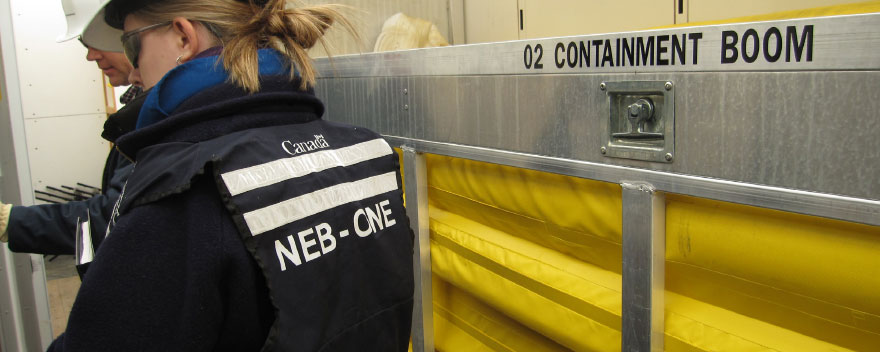

NEB in the North
Northern Preparedness
Northern Engagement 2014
In 2014 the Board continued its northern engagement activities through meetings with communities, youth, governments, environmental non-government organizations, regulatory agencies, and land claim institutions. Over 30 such meetings have taken place involving the NEB’s Chair and CEO, Board Members, and NEB staff in 2014. Through these meetings the Board demonstrated its commitment to listening to those who would be most affected by oil and gas activities in Canada’s North.
Engagement initiatives also involved the Board’s continuing participation in a number of working groups, committees, and conferences. These have included the NWT Board Forum, the Arctic Council, the Beaufort Regional Environmental Assessment, the Arctic Security Working Group, and emergency preparedness exercises (such as the CANUSNORTH exercise conducted in September 2014). The NEB also participated in the inaugural meeting of the Arctic Regulators Forum, where regulators share lessons learned and best practices, and discussed regulatory issues. NEB Board Members and staff made presentations at several conferences including the Inuvik Petroleum Show, the Canada-United States Northern Oil and Gas Research Forum, the North of 60 Aboriginal Land and Resources Development Conference, and the 42nd annual Yellowknife NWT Geoscience Forum.
Regulatory Developments
In January 2014, the Government of Canada introduced a new Bill, the Energy Safety and Security Act (Bill C-22), in Parliament which proposes important changes to the Canada Oil and Gas Operations Act (COGOA) and the Canada Petroleum Resources Act (CPRA) to provide for open and transparent processes in the North. The Bill would, for example, enable the NEB to conduct a public hearing in relation to the exercise of any of its powers or the performance of any of its duties under COGOA, and reduce the scope of privilege associated with CPRA and COGOA filings. The changes would also allow the Board to establish and manage a participant funding program for environmental assessments where CEAA 2012 applies.
Additionally, the Board undertook to update its Filing Requirements for offshore drilling in the Canadian Arctic to address information expectations for emergency management planning, and actively sought feedback on appropriate guidelines for Financial Responsibility for operating companies.
Devolution
On 1 April 2014, the Government of the Northwest Territories (GNWT) assumed responsibility for onshore oil and gas activities in the NWT outside the Norman Wells Proven Area, and other miscellaneous lands. The NEB and GNWT signed a Service Agreement to allow the NEB to provide technical services and advice to support the GNWT’s oil and gas regulatory functions for projects, and transfer records post-devolution. The NEB is committed to supporting the GNWT and the Government of Canada where it can to facilitate the seamless transition of oil and gas regulatory responsibilities in the NWT.
The Board continues in specified areas to have regulatory responsibilities for oil and gas exploration and production activities under the Canada Oil and Gas Operations Act (COGOA), the Canada Petroleum Resources Act (CPRA), the Northwest Territories Oil & Gas Operation Act (OGOA) and the Northwest Territories Petroleum Resources Act (PRA).Footnote 1
The NEB also continues to have regulatory oversight under the NEB Act for pipeline projects that cross Territorial borders in the North - such as Enbridge’s Norman Wells Line 21.
Arctic Offshore Drilling - Same Season Relief Well (SSRW) Technical Proceedings
During the Review of Offshore Drilling in the Canadian Arctic the Board reaffirmed its SSRW policy that says the applicant must demonstrate, in its contingency plan, the capability to drill a relief well to kill an out-of-control well during the same drilling season. The intended outcome of this policy is to minimize harmful effects on the environment. An applicant wishing to depart from the policy would have to demonstrate how they would meet or exceed the intended outcome of the policy. In spring 2014, both Imperial Oil Resources Ventures Limited (IORVL) and Chevron Canada Limited (Chevron) requested an advance ruling on whether their respective well control approaches would meet the intended outcome of the NEB’s SSRW Policy. The Board determined that it would be beneficial, early in the regulatory review process, to establish whether the proposals would meet the intended outcome of the SSRW Policy, as it is a major element of both projects.

On 11 July 2014 the Board granted the requests of IORVL and Chevron and initiated two SSRW Technical Proceedings. The Board invited public comment on a Draft List of Issues for the Technical Proceedings and released a Revised List of Issues on 4 September 2014. The submission of the detailed proposal from IORVL is pending. On 17 December 2014, Chevron notified the Board that it will not be proceeding with an SSRW Technical Proceeding.
Geophysical, Drilling and Production Applications
The NEB granted two geophysical operations authorizations, two drilling and production operations authorizations, and five well approvals. Also of note the NEB posted the first two hydraulic fracturing fluid product component information records for the Northwest Territories on the FracFocus.ca website.
CANUSNORTH Exercise - 2014
Under the Canada-United States Joint Marine Pollution Contingency Plan (JCP), the Canadian and United States Coast Guards are required to exercise each geographic annex to the plan every two years. In September 2014 in Juneau, Alaska, the NEB participated in the CANUSNORTH discussion-based tabletop exercise for a well control incident scenario in the Canadian Beaufort Sea.
CANUSNORTH is the short form used to refer to the Annex of the Canada-United States Joint Marine Pollution Contingency Plan (JCP) that covers the Beaufort Sea. The JCP defines the roles and responsibilities of the various players who would participate in the cleanup efforts of a marine pollution incident (in the unlikely event that it were to occur), in the contiguous waters between Canada and the United States. The biannual exercises are alternately hosed by each country.
In 2014, the NEB was a member of the Joint Design Team for the exercise along with the US Coast Guard (host), the Canadian Coast Guard, and nine other U.S. and Canadian agencies or organizations.
Sixty participants from 16 organizations shared information about the challenges of the regional northern geography, infrastructure, transportation and the multi-jurisdictional interactions and agencies’ roles. The exercise allowed the various federal, state and territorial agencies and Alaskan industry responders to gain an awareness and understanding of emerging or potential Beaufort region maritime activities and the opportunities to enhance preparedness for marine pollution events.
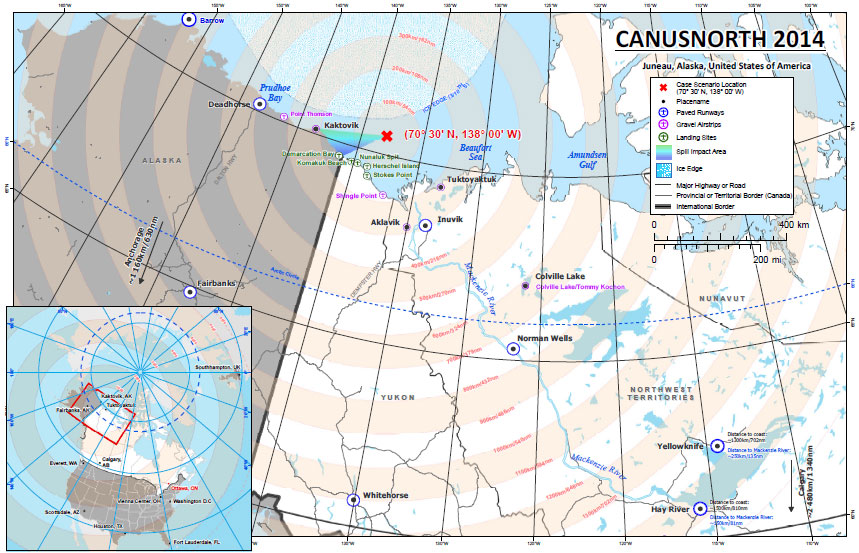
View a larger version of this map [PDF 322 KB]
Promoting Strong Outcomes for Safety, Security and the Environment
The safety of Canadians and protection of the environment in the construction, operation and abandonment of pipeline facilities regulated by the NEB are the Board’s top priorities, and have been a part of our mandate since 1959.
We are Canada’s energy regulator and safety is our top priority. Our safety programs are designed to make sure companies are effective in managing safety and environmental protection throughout the entire lifecycle of a pipeline - from design to construction, operation and through to abandonment.
We maintain a proactive approach to incident prevention and we take all available actions to protect the environment and the public.
In order to deliver on our mandate, we have regulations in place that set clear expectations for industry. We evaluate project proposals, monitor compliance and enforce rules.
Holding Companies Accountable
The NEB’s expectations of regulated companies are set out in the Acts and regulations relevant to the Boards mandate, as well as Board directions and orders. Companies are also expected to adhere to any commitments they make in their submissions to the Board throughout all phases of regulatory oversight. This combination of performance based management practices, prescriptive standards and project-specific conditions mean that all aspects of a company’s operation are governed by legal requirements, from design through to abandonment. Companies are responsible for complying with these requirements in order to manage safety and security, and to protect the environment during the lifecycle of their facilities and pipelines. The NEB holds its regulated companies accountable against these expectations using a rigorous compliance verification and enforcement program, and through enforcement actions.
Compliance Verification Activities (CVA)
The Board uses CVAs to gather information about the state of compliance in a specific area of a company’s operations or to investigate whether companies are taking the appropriate preventive or corrective actions. The Board’s suite of CVAs includes:
- inspections (of facilities under construction or in operation)
- emergency exercise evaluations
- emergency procedures manuals reviews
- compliance meetings (to check the progress of programs or corrective actions)
- management system audits, and
- reviews of post-construction monitoring reports.
In 2014, the NEB conducted a total of 353 compliance activities related to security, public safety and environmental protection, as compared to 303 compliance activities in 2013 - as seen in Table 4. We continue to increase the overall number of CVAs we do to determine the adequacy, effectiveness and implementation of a company’s Management System, in the areas of Emergency Management, Integrity, Safety, Security and Environmental Protection. Compliance verification activities are designed to provide feedback to the company, to determine if legislation and expectations are being followed, to assess if enforcement is required, and to compile information on the company’s performance for the purposes of establishing trends and for assessing the amount of oversight required in the future.
During a CVA, Inspection Officers are able to observe the compliance status of regulated companies. Where a noncompliance is observed, follow-up is undertaken to verify corrective actions have been put in place and to determine appropriate enforcement actions. The results of compliance verification activities are used along with other inputs such as incident data to inform the NEB’s compliance plan for the coming year.
| Compliance Activity | 2013 Completed Activities | 2014 Completed Activities |
|---|---|---|
| Inspections | 169 | 230 |
| Emergency Exercises | 12 | 13 |
| Emergency Procedures Manual Review | 22 | 19 |
| Compliance Meetings | 70 | 64 |
| Audits | 4 | 6 |
| Report Reviews | 26 | 21 |
| Total: | 303 | 353 |
Enforcement Actions
Where non-compliances have been noted through CVAs, enforcement actions are used to achieve compliance as quickly and as effectively as possible. Achieving compliance reduces hazards and protects the safety of workers, the public, the environment and property. The NEB’s guiding enforcement policy states:
NEB enforcement tools are not mutually exclusive and more than one measure may be employed to obtain compliance, deter future non-compliance or to prevent incidents/ accidents. When safety, security or environmental protection issues are identified, the NEB will use the most appropriate and efficient enforcement tool.
The Board has taken the following enforcement actions in 2014:
- 302 Notices of Non-ComplianceFootnote 2 (NNC) and Assurances of Voluntary Compliance (Canada Labour Code-related issues)
- 3 Inspection Officer Orders (IOO)
- 5 Safety Orders
- 6 Administrative Monetary Penalties (AMPs)
Emergency Management
The NEB holds regulated companies responsible for anticipating, preventing, managing and mitigating incidents of any size and duration. Companies are accountable for leading the response to incidents.
When the NEB is notified of an incident, its top priority is safety and security of people, and protection of property and the environment. The Board has a comprehensive Emergency Management Program, which can include a field response. The NEB role as lead regulatory agency is to monitor, observe and assess the overall effectiveness of the company’s emergency response. Further, the NEB makes sure that the pipeline is safe to restart and we verify that a regulated company conducts an adequate and appropriate clean-up and remediation of any environmental effects resulting from the incident.
NEB staff conducted on-site responses to the following four incidents in 2014. These incidents were:
- Enbridge Pipelines Inc. station crude oil leak of 12 to 20 m³ released in Regina, Saskatchewan (SK).
- TransCanada PipeLines Limited, Emerson Lateral Line 400-1 downstream of MLV 402-1, Canadian Mainline, natural gas pipeline rupture, near Otterburne, Manitoba (MB).
- NOVA Gas Transmission Ltd. rupture and release of gas on the North Ferrier Lateral 18” line near Rocky Mountain House, Alberta (AB).
- Enbridge Pipelines Inc. Regina Terminal pump station crude oil release of 215 m³. The pump station is located in the industrial section of Regina, SK.
The NEB expects that companies will incorporate lessons learned from an incident into its Management System with the goal of preventing future incidents.
Safety Culture
The analysis of several incidents has revealed that organizational culture, specifically the values, assumptions, beliefs, and behaviours related to safety and risk, may positively or negatively influence safety and environmental protection outcomes. This has highlighted the need for companies to foster the development of an organizational culture in which safety is a core value demonstrated by all personnel at all times.
Culture influences what people see, hear, feel, and say. Most importantly, it influences the decisions and actions of people in an organization. These behaviours ultimately drive safety performance. For this reason, the Board has embarked on a path to strengthen and improve industry-wide performance and awareness of the role that culture plays in contributing to or building defenses against incidents.
As part of this effort, the NEB, in coordination with the Canada–Nova Scotia Offshore Petroleum Board, and the Canada–Newfoundland and Labrador Offshore Petroleum Board, developed a safety culture discussion paper with draft definition and framework, which was released for public comment in October 2013.
The consultation process ended on 30 January 2014. A number of stakeholders and interested parties provided comments and recommended improvements to the background material and draft safety culture framework.
The Board considered these comments in the development of its Statement on Safety Culture released in June 2014. This Statement is intended to promote learning and a shared understanding of safety culture across the oil and gas sector in Canada. It is also intended to express the Board’s expectations of regulated companies to build and sustain a positive safety culture.
The NEB has continued this effort by engaging with stakeholders, subject matter experts, and other interested parties. Following the release of the Statement on Safety Culture, in June 2014, the Board led the creation of a North American Regulators Working Group on Safety Culture. The group’s purpose is to collectively advance and coordinate regulatory initiatives and outreach related to safety culture. It has recently begun developing safety culture indicators that may be used by regulators to gather intelligence of potential cultural hazards and best practices found across industry.
The Board intends to include these new indicators in its inspections, audits, and incident investigations. Related lessons will be shared with stakeholders and the public in order to improve awareness of safety culture’s role in supporting or detracting from safety and environmental protection. In addition, individual company information will supplement other performance data collected by the Board in order to inform the regulators’ risk informed approach to compliance activity planning and oversight.

Incident Management
Incidents are a reporting requirement under the NEB’s regulations. In 2014 the Board provided additional guidance to its regulated companies as to what constitutes an incident (NEB Event Reporting Guidelines). In this document the NEB directed companies to use the precautionary approach to reporting which can be summarized as “when in doubt, report”. This will be used in circumstances where it is unclear whether an event meets the definition of an incident under the NEB regulations.
At the same time the above document was released, the NEB also rolled out its new Online Event Reporting System (OERS) for use by regulated companies to report events, including incidents, to both the NEB and the Transportation Safety Board (TSB). The new system mandates specific information from companies on various events which the NEB will use to identify trends or areas of focus for companies.
The NEB holds regulated companies responsible for anticipating, preventing, mitigating and managing incidents of any size and duration. Companies are accountable for leading the response to incidents and they are responsible for addressing impacts associated with incidents. When the NEB is notified of an incident, its top priority is safety and security of people, and protection of property and the environment.
The Board has a comprehensive Emergency Management Program, which can include a field response. Our role as lead regulatory agency is to monitor, observe and assess the overall effectiveness of the company’s emergency response.
The NEB may become a member of Unified Command, as appropriate, in the Incident Command System when the company involved uses this incident management system. The NEB Incident Commander, as part of Unified Command, will sign off on the Incident Action Plan (IAP) that establishes the objectives and priorities of the response, the resources and the operational period. Further, we verify that a regulated company conducts an adequate and appropriate clean-up and remediation of any environmental effects resulting from the incident.
In 2014, there were 76 reportable incidents under the Onshore Pipeline Regulations (OPR) compared to 121 in 2013 - an overall decrease of approximately 37 per cent. Figure 5 shows the number of events which occurred from 2008 through 2014 that resulted in an incident. Many variables affect the number of incidents that are reported on an annual basis however it is encouraging to see that number falling.
Overall, incidents are down in each category with the exception of fires/explosions and significant adverse effects on the environment. In addition, there were two multiple incident events whereby a gas release also ignited, so they are reportable as both a gas release and a fire under the OPR. Figure 6 compares the number of reportable incidents by type in 2013 to 2014.
The following sections break down the different incident types and describe what each type is, what the data tells the NEB as well as what actions the NEB has and continues to do as a result of incident reporting.
Figure 5: Total Number of Events Resulting in Incidents under the Onshore Pipeline Regulations (OPR) 2008-2014
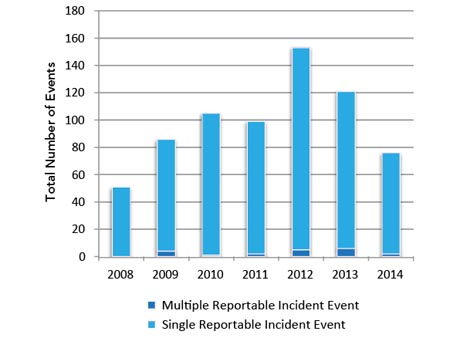
Figure 6: Number of OPR Incidents by Type, 2013 vs. 2014
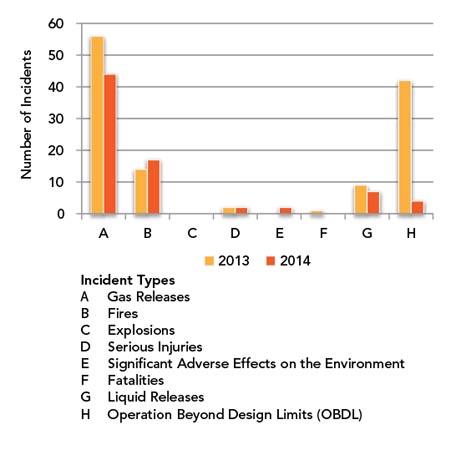
Fatalities
Every life is precious, and the Board works tirelessly toward a ‘zero fatality’ performance associated with its regulated pipelines. Given that goal, it is encouraging to note that during 2014 there were none.
The OPR requires companies to report all fatalities associated with the construction, operation or abandonment of an NEBregulated pipeline. Over the seven years from 2008 through 2014, six fatalities have occurred on NEB-regulated facilities all of which are investigated by NEB staff. The most common cause of fatalities on NEB-regulated facilities is vehicle accidents.
The NEB will continue to focus on safety during inspections and continue to work toward improving safety culture in industry.
Serious Injuries
The OPR requires companies to report serious injuries associated with the construction, operation or abandonment of an NEB-regulated pipeline. By far the most common serious injury reported is fractures of major bones; both of the serious injuries reported in 2014 were of this nature. Since 2008 a total of 22 serious injuries have been reported on NEB-regulated facilities (see table 7). The data suggests that more serious injuries occur in years where there are higher levels of pipeline construction.
NEB inspectors focus on safety of workers during inspections and regularly, often on multiple occasions, inspect large pipeline construction projects. The NEB has also issued safety advisories to industry when it has identified an emerging issue or recurring issue that requires additional attention from several companies. For example the NEB issued a safety advisory in 2014 regarding material handling and overhead crane equipment.
The NEB will continue its work on proactively identifying areas that industry can focus on to improve the overall safety of the public and employees.
Significant Adverse Effects on the Environment
A significant adverse effect on the environment is part of the definition of incident under the OPR. The NEB provided additional clarification on this type of incident in the NEB Event Reporting Guidelines. A significant adverse effect on the environment is defined as: the release of product or physical substances (e.g. sediment or mud) at a concentration or volume sufficient to cause an irreversible, long-term, or continuous change to the ambient environment in a manner that causes harm to human life, wildlife, or vegetation. The most common incidents that fall into this category are:
Releases of toxic substances that are not hydrocarbon or commodity products such as glycol (antifreeze); and
Releases that are less than the reportable limit of 1.5 m³ but affect sensitive environments such as waterbodies.
There were no significant adverse effects on the environment incidents in 2013, however there were two incidents in 2014. One was related to a leak of 1.365 m³ of glycol on company property while performing integrity testing on the compressor station glycol lines. The other involved the loss of six litres of lube oil into the Peace River. The equipment that caused the leak was isolated, taken off-line to be cleaned for inspection, and was subsequently repaired.
Prior to the NEB Event Reporting Guidelines referenced above, companies were unclear on what the NEB considered to be an incident that causes a significant adverse effect on the environment. The Board has since clarified the reporting requirements for companies. Going forward, the NEB expects that there will be an increased awareness on reporting incidents such as these which will allow the NEB to use the resulting data more effectively.
Table 7: Number of Serious Injuries reported under the OPR 2008-2014
| 2008 | 2009 | 2010 | 2011 | 2012 | 2013 | 2014 | |
|---|---|---|---|---|---|---|---|
| Serious Injury | 3 | 8 | 0 | 1 | 6 | 2 | 2 |

Fires and Explosions
The OPR requires that companies report unintended fires associated with the construction, operation or abandonment of an NEB-regulated pipeline regardless of size or cause. The vast majority of the reported incidents from 2008 to 2014 that occur in this category are small electrical or equipment fires that are extinguished quickly by on-site staff.
Figure 8 shows the number of fires and explosions that have occurred annually since 2008. In 2014 there were 17 reports of fires in 2014 and no explosions. Similar to other years the most common type of fire in 2014 was small electrical or equipment fires.
In 2012 after an increase in the number of small fires NEB inspectors identified the need to focus on company equipment maintenance and inspections during compliance verification activities. NEB inspectors will continue to do so going forward.
Total Volumes of Liquids Released vs. Number of Liquid Releases
The OPR requires companies to report all liquid hydrocarbon releases >1.5 m³ in volume as incidents. Regardless of cost the NEB expects companies to address all impacts of a release.
A total of seven reportable liquid releases occurred in 2014 down from nine liquid releases in 2013. The amount of product released totaled 266.25 m³ with 80 per cent of the product released in 2014 being attributed to a single incident.
Six liquid releases were equipment-related: one was due to a failed flex hose, another occurred during maintenance activities and involved a 2” fitting, two involved a failed gasket, one involved a crack at the foot of a valve, and the last incident involved a leak from a tank mixer seal. The seventh release incident was due to a failure to follow procedures while offloading oil from a truck.
In six of the seven incidents the product released was entirely contained within company property. In the remaining incident, a spray of crude oil was found on top of a layer of snow adjacent to company property. All offsite impacts were completely cleaned up.
Over the last few years, the Board has issued a number of Safety Orders to companies operating facilities that had experienced larger spill volumes. The Safety Orders required improvements to Integrity Management Programs of the respective companies as well as mandating pressure reductions in circumstances that warrant those actions.

Figure 8: Number of Fires and Explosions reported under the OPR, 2008-2014
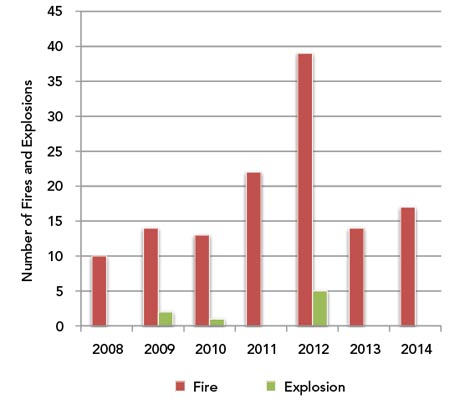
Figure 9: Total Volumes of Liquids Released vs. Number of Liquid Releases reported under the OPR, 2008-2014

Natural Gas and Other High Vapour Pressure Releases
The OPR requires companies to report all unintended natural gas releases regardless of volume. In 2014 here were 44 gas releases reported as compared to 56 in 2013. The most common type of release that is reported is gas escaping from fittings or small connections on above-ground facilities.
Figure 10 shows gas releases from 2008 to 2014. The increase in reported gas releases in 2009 is consistent in timing with when the NEB acquired jurisdiction over a large amount of natural gas pipelines in Alberta. The decrease in gas releases since 2012 is consistent in timing with a number of safety orders issued by the NEB in 2013.
The NEB works proactively to prevent the release of product from its regulated pipelines and has initiated several actions that can contribute to a reduction in the overall amount of reported gas releases. In 2013, the NEB issued safety orders related to a series of gas releases on two separate pipelines. The safety orders mandated a reduction in pressure on those lines. Similarly, another safety order that mandated a pressure reduction was issued in relation pipelines that are not able to be inspected using in-line inspection tools.
The safe and secure operation of pipeline infrastructure is of paramount importance to the NEB. As a result, the NEB will continue to proactively identify areas for improvement or areas of higher risk and direct companies to focus on these areas to increase the overall safety of pipelines.
Operation Beyond Design Limits
The operation of a pipeline beyond its design limits (OBDL) is defined as: any operation of the pipeline beyond the criteria for which the pipeline was designed and/or the operation of the pipeline beyond criteria imposed to mitigate a condition on the pipeline (a typical example of this mitigation is an NEB ordered pressure reduction).
The most common type of OBDL incident is an overpressure where a company exceeds the maximum operating pressure of a pipeline or facility component.
Reported OBDL incidents in 2012 and 2013 are higher than other years due to an investigation completed by NEB staff which uncovered additional unreported OBDL (see below for NEB actions in circumstances such as these). That being said, even when accounting for this difference, overall reported OBDL incidents have declined in 2014 in comparison to 2012 and 2013. The NEB will continue to monitor this data and use it to inform additional compliance and enforcement actions.
In all cases, the company is required by legislation to demonstrate that an OBDL did not impact the integrity of the pipeline. Where this is not true or unclear the NEB has and will continue to impose additional mitigations such as ordering a pressure reduction to ensure the safety of the pipeline is maintained.
In situations where the NEB has identified a series of overpressure incidents by one company, we have taken further enforcement actions, such as issuing a Safety Order requiring the company to conduct an analysis of its pipeline system to identify and correct the root causes of the overpressure occurrences.
Figure 10: Number of Natural Gas and Other High Vapour Pressure Releases reported under the OPR, 2008-2014
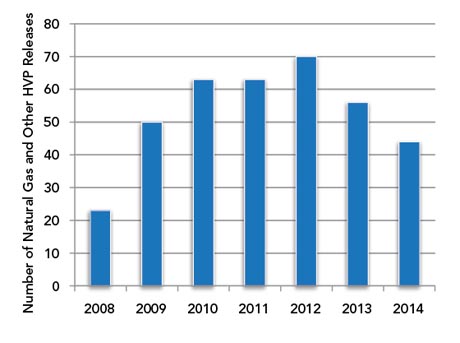
Figure 11: Number of OBDL Incidents reported under the OPR, 2008-2014
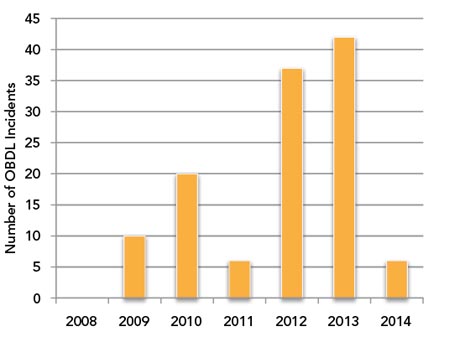
Furthermore, the NEB will issue safety advisories to all regulated companies regarding concerns with the recurrence of overpressure incidents on NEB-regulated facilities. One such safety advisory outlined preventative actions that could be taken to avoid overpressure incidents and informed companies that overpressure incidents were hazards that could lead to future pipeline integrity issues.
In 2014, the NEB provided additional guidance to companies to further clarify what constitutes an OBDL (see NEB Event Reporting Guidelines). It is expected that this clarification will result in more consistent reporting of OBDL incidents.
Pipeline Performance Measures
The NEB required companies that operate over 96 per cent of NEB-regulated pipelines to submit data on a suite of leading and lagging performance measures by 1 April 2014. The development of leading pipeline performance measures is unprecedented. It raises the bar on the Board’s expectations for the oil and gas industry and also lays the groundwork for companies the NEB regulates to produce measures of their own. These measures challenge companies to take a hard look at how they manage the risks associated with their operations. The measures also promote continual improvement, and set the stage for further initiatives to assess safety culture in pipeline companies. A summary report on the company aggregate data was released by the NEB in November 2014. It identified cumulative work conducted by companies to make pipelines safe that included 12,795 construction personnel were trained on environmental protection; almost 6,000 kilometres of agricultural land was restored since 2009; the equivalent of 38,341 kilometres of multiple pipeline inspections were conducted for various hazards, allowing companies to proactively address defects; and 330 emergency exercises were conducted.
The data generated from these measures will be used by the Board to continually improve the regulation of pipeline operations. The NEB expects that it will take at least three annual reporting cycles to identify meaningful trend information. However, the Board will immediately begin using the performance measures data to inform its compliance verification planning.
Damage Prevention
Preventing damage to pipelines is a shared responsibility. As pipelines are buried, they can be at risk for accidental damage from excavation or construction activity nearby. This type of damage is preventable. Unauthorized Activities (UA) occur when the appropriate permission for an excavation or construction activity is required but not obtained, or when safety instructions are not followed. Ground Disturbance is the most hazardous UA, and it is also the most consistently reported. Our outreach and engagement activities and damage prevention public education material focuses on safe excavation and how to live and work safely near pipelines.
UAs are considered by the Board to be a near miss incident which means they are predictors of future behaviour, so the NEB uses this metric as a valuable leading indicator. We use the information collected on the UA reporting form to develop the Damage Prevention compliance verification activity plan and our targeted outreach and engagement strategy. This is our opportunity get the damage prevention message to the parties who most need to hear it and to affect change in at-risk behaviour.
There were 132 reported UAs in 2014, compared to 113 for 2013. The increased number of reports shows that there is not necessarily more UAs occuring, but rather that there is better awareness of the reporting requirements of National Energy Board Pipeline Crossing Regulations, Part II (PCR II).
Figure 12: 2014 Unauthorized Activities by Province
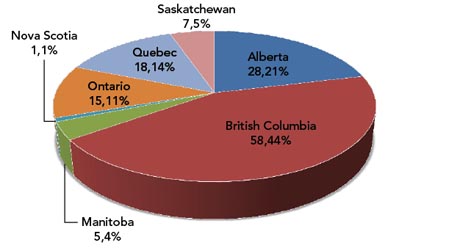
When broken down by province, the data shows that nearly half of the UAs occurred in British Columbia (BC). There are a few reasons that help explain why BC has such a high number of UAs compared to other regions of Canada;
- High pipeline density in the lower mainland where the majority of the UAs occur;
- High population density in those areas;
- Pipeline companies in BC are very diligent in reporting UAs, and;
- Provincial regulations for distribution of gas and electricity in BC do not require companies to physically mark their facilities, fostering a culture where many excavators do not call/click before they dig.
Federally regulated pipeline companies provide directions, physical marks on the ground and generally require pipeline company personnel to be onsite during ground disturbance activities on the right of way (RoW).
The number of UAs is normalized across each province by calculating the number of UAs per 1000 km of pipeline. This data shows the hotspots for UAs and informs our outreach and engagement strategy, and is a factor in how compliance verification activities are planned.
Quebec and BC stand out with UA rates that are much higher than the national average of 1.84 UAs per 1000 km of pipeline.
The reasons for the high UA rate in Quebec are similar to some of those in BC;
- Pipeline in a high population density area; and,
- Diligent UA reporting by a particular pipeline company
In 2014 damage prevention staff completed 21 damage prevention related compliance verification activities. Through the Damage Prevention Outreach and Engagement plan, staff made presentations at seven conferences and workshops in Quebec, Ontario, Alberta and BC with the excavator and contractor stakeholder groups as the primary audience.
Staff have several compliance verification and engagement activities planned for both Quebec and British Columbia in 2015/16. As the Federal Regulatory Champion of the Canadian Common Ground Alliance (CCGA), NEB staff work closely with the CCGA regional partners to ensure that we engage with the all stakeholders in the ground disturbance community.
UAs are categorized into three types of activities; ground disturbance, encroachment and vehicle crossings.
Regardless of location, ground disturbance is the most prevalent, and dangerous type of activity. These are excavators who dig on the RoW or in the safety zone, some examples are:
| Province | Km of pipeline | Number of Reported UAs 2014 | UAs/ 1000 km |
|---|---|---|---|
| Alberta | 30700 | 28 | 0.91 |
| British Columbia | 7800 | 58 | 7.44 |
| Manitoba | 5600 | 5 | 0.89 |
| New Brunswick | 615 | 0 | 0.00 |
| Northwest Territories | 840 | 0 | 0.00 |
| Nova Scotia | 1020 | 1 | 0.98 |
| Ontario | 10995 | 15 | 1.36 |
| Quebec | 1480 | 18 | 12.16 |
| Saskatchewan | 12570 | 7 | 0.56 |
| Yukon | 20 | 0 | 0.00 |
Figure 14: UAs by Type
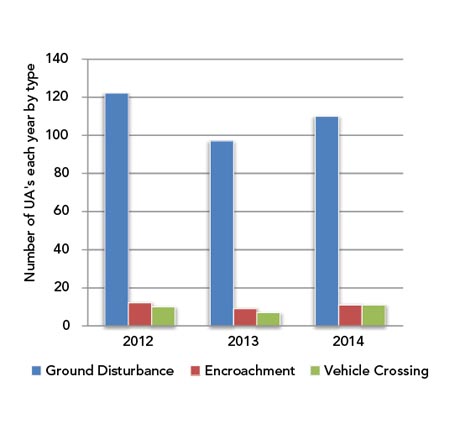
Figure 15: Violator Category
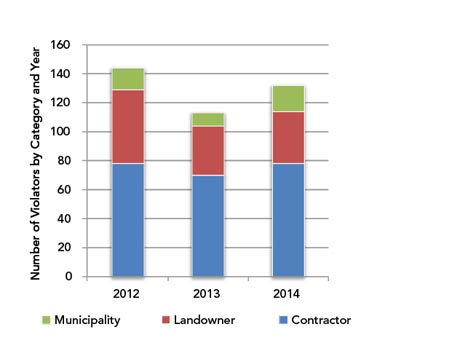
- Drilling postholes for fences and other structures
- Excavating for buildings or other structures
- Trenching
- Clearing/planting large trees
- Cleaning ditches
- Building roads
- Deep tilling and sub-soiling (>30 cm)
ContractorsFootnote 3 who are professional excavators represent the majority of UA violators. The number of UAs by contractor remain relatively the same for 2014, while Landowner UAs are declining. UAs by municipalities, which include Provincial entities such as Ministries of Transportation, are on the increase. To address the increase in UAs by municipalities, we initiated information exchange meetings with a number of municipalities with repeat violations.
Environmental Protection
Making sure the right safety measures are in place and taking the appropriate enforcement actions are key to protecting the environment. The Board has approximately 75 staff with expertise in environmental protection, including those specializing in:
- physical and meteorological environment
- soil, soil productivity and vegetation
- wetlands, water quality and quantity
- fish, wildlife, and their habitat
- species at risk or species of special status and related habitat
- heritage resources
- traditional land and resource use, and
- human health, aesthetics and noise.
Companies planning to build energy facilities are required to satisfy the Board that they have anticipated all possible environmental issues. The NEB conducts an environmental assessment during its review of applications for projects under its jurisdiction. The Board also audits and inspects a company activities including routine maintenance and monitoring procedures over the lifecycle of an energy project. We do this in order to verify compliance with regulatory requirements and any conditions imposed.
CEAA 2012 - Report on Activities
For projects located on federal landsFootnote 4, section 67 of the Canadian Environmental Assessment Act 2012 (CEAA 2012) requires that before federal authorities make any decision that would allow a project to proceed, they must determine whether a project is likely to cause significant adverse environmental effects. Under section 71 of CEAA 2012, the NEB is required, at the end of each fiscal year, to report to both Houses of Parliament on its activities under sections 67, 68 and 69 of CEAA 2012 during the previous fiscal year.
During the 2013-2014 fiscal year, the NEB completed environmental assessments for two projects that are located on or that cross federal lands. In each case, the NEB determined that carrying out the project would not likely cause any significant adverse environmental effects and approved the project.

Projects on Federal Lands: 1 April 2013 - 31 March 2014
| Applicant | Project | Brief Description | Adverse Environmental Effects |
|---|---|---|---|
| Forty Mile Gas Co-op Ltd. | Forty Mile Gas Co-op application to Abandon, Order XG-F73-4-98 |
Abandonment of three parallel pipelines, each 35 m long, and associated risers, meters, and piping, located at the Canadian Customs Port of the Entry office building in Wild Horse, at the Canada-United States of America Border. | Not Significant |
| Hydro One Networks Inc. | Application to complete transmission tower refurbishment and replacement work on IPL B3N | Refurbishing 19 towers and replacing five towers on IPL B3N near Sarnia, ON. A section of the B3N IPL is located on Aamjiwnaang First Nation reserve lands. | Not Significant |

Energy Markets in 2014
As part of its regulatory mandate, the Board closely monitors North American energy markets. The goal is to understand ongoing changes in the relationships between supply, infrastructure, and prices, as well as staying current on fast-evolving energy market place. In addition to intelligence gathered in its monitoring role, the Board’s understanding these market relationships is enhanced by the information submitted as part of applications to construct and modify facilities, establish tolls and tariffs, and provide export or import authorizations.
Canada’s Energy Story - 2014
In 2014, Canada’s crude oil production and exports increased, driven mostly by oil sands production growth. Global benchmark crude oil prices, strong during the first half of the year, shrank by nearly 50 per cent from their peak levels by year-end. This oil price collapse occurred as a result of a developing glut in global oil supply, due in part to rapidly expanding United States (U.S.) tight oil production, and weaker than expected demand from Europe and Asia. In addition, OPEC (Organization of the Petroleum Exporting Countries) at its November meeting, contrary to its common practice of cutting production to support prices, this time declined to cut production. Alongside these global price movements, oil pipeline capacity additions in the U.S. and higher crude-by-rail volumes increased crude oil exports for Canadian producers. Meanwhile, Eastern Canadian refineries imported record levels of U.S. light crude oil, displacing traditional sources from abroad.
Natural gas prices increased due to the 2013-14 winter being one of the coldest in 35 years. Increased demand for home heating in both Canada and the U.S resulted in significant withdrawals from storage inventories. During the spring and summer, throughputs on TransCanada’s Mainline increased year-over-year to refill depleted storage inventories in eastern Canada and the U.S. Production in Canada was similar to last year’s levels, while production increased considerably in the U.S. Overall North American production growth has producers looking to ship natural gas out of North America. In 2014, the NEB received a record number of applications to export liquefied natural gas on a long-term basis.
The cold 2013-14 winter also impacted propane markets. In February 2014, in response to rapid price increases, scarcity of wholesale propane, and reports of shortages, the Ministers of Natural Resources and Industry asked the NEB and Competition Bureau to examine issues faced by propane markets during the 2013-14 winter, and to investigate the possibility of anti-competitive activities. On 29 April 2014, the NEB and Competition Bureau released the Propane Market Review. While tight supply and high prices continued for most of the winter, propane prices came down considerably after peaking in late January and local delivery problems eased as severe weather let up in major propane consuming regions.
In November 2014, the NEB provided a Market Snapshot update on propane, noting that “the propane market is better positioned heading into [the 2014-15 winter] than a year ago”. By the end of 2014, propane inventories in Canada and the U.S. had reached record highs and propane prices fell to multi-year lows at major hubs in Canada and the U.S. - a complete reversal from what was observed during the 2013-14 winter.
In the electricity market, Canada’s supply mix continued to evolve in 2014. Renewable generation grew, led by an addition of 1871 MW (megawatt) of wind. Multiple large hydro projects are under construction across the country, from expansions at dams in the interior of B.C. to large additions in northern Manitoba, northeastern Quebec and Labrador. Ontario’s coal phase-out concluded with the shut-down of its Thunder Bay generation facility. In the summer, the world’s first commercial-scale carbon capture and storage coal plant project of its kind started operations in Saskatchewan.
Canadian Energy Import/Export Volumes and Values
Crude Oil
Canada is a net crude oil exporter and the largest supplier of crude oil to the U.S. In 2014, total Canadian crude oil exports averaged approximately 2.84 million barrels per day (MMb/d), which is a 9.2 per cent increase from 2013. In 2014, the total value of crude oil exports is estimated at C$93.9 billion based on an average export price of C$91.22 per barrel. Approximately 96 per cent of crude oil exports were to the U.S.
Figure 16: Total Crude Exports 2005 - 2014
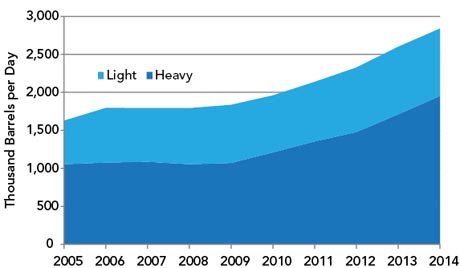
Natural Gas
In 2014, Canadian natural gas exports were approximately 77 billion cubic metres (m³), an average of 211 million cubic metres per day (m³/day). Including 0.6 billion m³ of liquefied natural gas imports, total natural gas imports were approximately 22 billion m³, an average of 60 million m³/day. Net exports were approximately 55 billion m³, or 151 million m³/day, which is similar to 2013. In 2014, the value of natural gas exports was approximately C$16.0 billion, and the value of natural gas imports was approximately C$5.4 billion.
Electricity
In 2014, Canadian electricity exports averaged 59.2 terawatt hours (TWh). Total electricity imports reached 12.8 TWh. Net exports decreased to 46.4 TWh, down 11 per cent from 2013 due to both decreased exports and increased imports. The total value of electricity trade in 2014 was approximately C$3.6 billion.
Figure 17: Natural Gas Net Exports 2005-2014 (Exports less Imports)
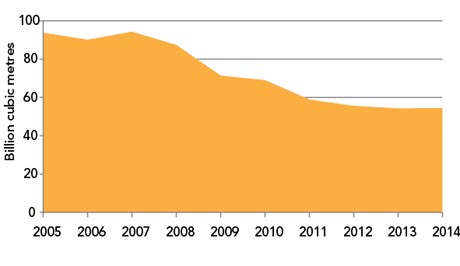
Figure 18: Electricity Net Exports 2005 - 2014 (Exports less Imports)
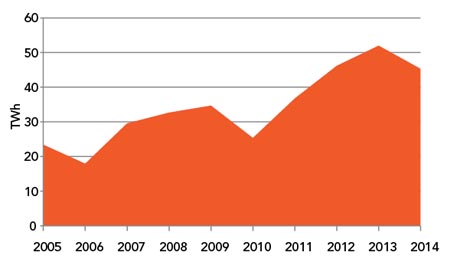
NEB Energy Reports Released in 2014
Canadian Energy Dynamics 2013 (released March 2014) - An overview of key developments in Canada’s energy markets in 2013.
Transportation System Report (released April 2014) - An assessment of the economic functioning of the pipeline transportation system, providing information about the major pipelines regulated by the Board.
Propane Market Review - A Joint Report by the NEB and the Competition Bureau (released April 2014) - An examination of the issues faced by propane markets during the 2013/14 winter, and an investigation on the possibility of anti-competitive activities.
Short-term Canadian Natural Gas Deliverability 2014-16 (released May 2014) - An outlook for Canadian natural gas production through 2016, and an examination of the factors expected to influence production over a three-year period.
Canadian Energy Overview 2013 (released June, 2014) -
A presentation of high level 2013 data on Canadian energy demand, supply and markets.
Assessment of Discovered Conventional Petroleum Resources in the NWT and Beaufort Sea (released November, 2014) - An assessment of the conventional resources in the two regions supported by petroleum estimates and data at a reservoir level.
Market Snapshots - Frequent, brief analytical reports on the functioning of energy markets.
Part VI - Export & Import of Natural Gas, Crude Oil and Electricity
Part VI of the NEB Act authorizes the Board to issue orders, licences and permits for imports of natural gas (including liquefied natural gas) and exports of: oil (including refined petroleum products), natural gas (including liquefied natural gas), natural gas liquids and electricity. Table 19 provides an overview of all orders, licences and permits issued by the Board in 2014.
| Totals in 2014 | New | Amendments | Renewals | Revocations | Total |
|---|---|---|---|---|---|
| Propane short-term export orders | 3 | 4 | 63 | 1 | 71 |
| Butane short-term export orders | 2 | 4 | 50 | 0 | 56 |
| Oil short-term export orders | 26 | 8 | 165 | 2 | 201 |
| Natural gas short-term export and import orders | 205 | 15 | 0 | 12 | 232 |
| Natural gas long-term licences (import and export) | 6 | 0 | 0 | 0 | 6 |
| Natural gas long-term orders (import and export) | 1 | n/a | n/a | n/a | 1 |
| Electricity export permits issued | 9 | 2 | n/a | 2 | 13 |
| Total | 252 | 33 | 278 | 17 | 580 |
NEB People and Culture
The NEB People Strategy
The Board takes pride in its technical and professional excellence as a regulator, and strives to attract, retain and develop highly qualified staff to work in a dynamic, results-based culture of excellence. Employees are our most valued resource and we depend on them to make our goals a reality. In our People Strategy, we commit to providing the following value proposition to staff:
- interesting and challenging work in the national public interest;
- a workplace that supports learning and professional development;
- a supportive and inclusive workplace, underpinned by a strong culture of values;
- a work/life balance that works for each person;
- a competitive compensation package; and
- effective leadership.
Employment Equity and Diversity
The National Energy Board is committed to employment equity and welcomes diversity in the workplace. A diverse workforce that mirrors the community strengthens the NEB and plays an important role in attracting and retaining talented employees.
We will continue to promote diversity within the workforce and continue to improve our representation in the various employment equity groups.
NEB is a Top 100 Employer in Canada!
In November, the NEB was again named as one of Canada’s Top 100 Employers for 2015 for the fifth year in a row (the NEB is a six-time winner as we were also named in 2009). In addition to that honour, we were also named as one of Canada’s Top 100 Family Friendly Employers for 2015, a designation that recognizes employers offering progressive and forward-thinking programs for employees with young children, other dependents, and/or family responsibilities.
The Board is pleased to receive these honours as they showcase not only the types of programs offered to employees, but they also focus on the employees themselves. The NEB is not just a Top 100 Employer and Family Friendly Employer; it is a “Top 100 Team” that strives for excellence in all that it does.
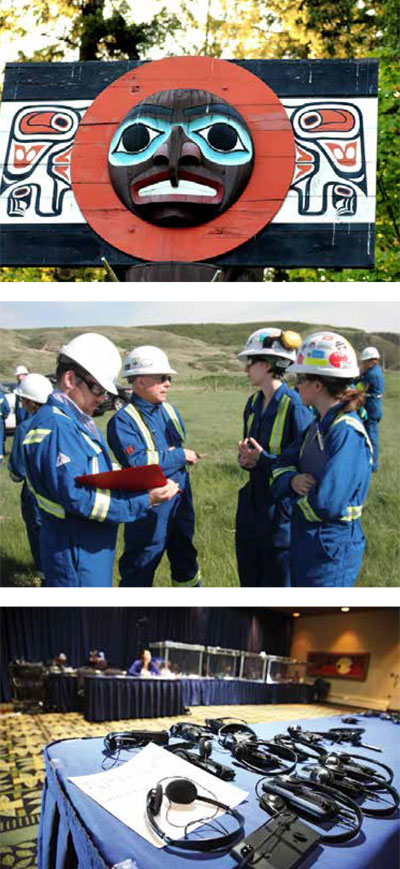
2015 - A Look Forward
Our Commitments to Canadians
Looking forward for 2015, the NEB will continue to strategically develop, refine and communicate our actions on pipeline safety and environmental protection, demonstrating a stronger link between our targeted safety and compliance actions and the safety performance of companies we regulate. We plan to increase our focus on trending, root cause and systemic issues that will lead to broader, more proactive compliance and enforcement actions, and ultimately, better pipeline safety and environmental protection outcomes. In addition, we will focus more oversight on not just preventing incidents, but also fostering the development of an industry safety culture in which incidents are less likely to occur.
Our ongoing focus on safety outcomes will be complemented with a more strategic, intensive approach to engaging with and listening to Canadians.
This means reaching out to Canadians as a whole, beyond the scope of our regulatory processes, with the goal of more fully understanding regional and national needs. Through active, transparent communication, the Board will hear what Canadians have to say to us, and be open to making changes based on those conversations.
Internally, we will work to develop and implement a framework for regulatory excellence. We are taking steps to define what regulatory excellence means for us as an organization, putting structure around our organizational self-assessment, bench-marking, and measurement. We will show, quantitatively as well as qualitatively, how we know our programs are focused on the right things and achieving the right results.
We remain focused on our primary goal: to help keep pipelines safe and protect the environment.
A Wealth of Experience - Board Bios
Chair / CEO
Peter Watson
Mr. Watson was designated as the Chair and CEO of the NEB of Canada on 13 June 2014. His term is for a period of seven years, on a full-time basis.
Mr. Watson has extensive senior executive leadership experience in energy, natural resources and environmental issues. In his most recent position as Deputy Minister of the Alberta Executive Council, he was responsible for the administration of the Executive Council Office, Cabinet and committees, and was also Head of the Alberta Public Service. Mr. Watson served as Deputy Minister, Alberta Department of Energy (2008-2011), Deputy Minister, Alberta Department of Environment (2005-2008), and Assistant Deputy Minister, Environmental Assurance Division, Alberta Environment (2002-2005). Previous to these senior positions with the Alberta government, Mr. Watson served as Regional Director, Southern Region, Alberta, and held various engineering and management positions at Alberta Environment. He was named Alberta’s Resource Person of the Year in 2011 by the Alberta Chamber of Resources. Mr. Watson holds a B.Sc. in Civil Engineering from the University of Alberta.

Vice-Chair
Lyne Mercier
Ms. Mercier was designated as Vice-Chair and alternate CEO of the NEB on 13 June 2014. Her term is for a period of seven years, on a full-time basis.
Ms. Mercier was first appointed as a permanent, full-time member of the NEB on December 17, 2008, for a term of seven years. Before joining the NEB, Ms. Mercier worked at Gaz Métro for over 29 years, serving 10 years in executive positions. At Gaz Métro she was director of the gas supply division, where she was responsible for strategic policy for natural gas supply and for the management of natural gas transmission, storage and supply contracts. Prior to that, she was head of the pricing division, where she was responsible for toll design and cost-of-service allocation studies.
Ms. Mercier holds a Bachelor of Commerce from St. Mary’s University and an Executive MBA from l’École des Hautes Études Commerciales.

Member
Roland George
Roland George was re-appointed in 8 August 2013 as a permanent Board Member of the NEB for another seven-year term. Mr. George was originally appointed on 8 August 2006. He has worked primarily in the private energy sector for over three decades. He was Senior Principal at Purvin & Gertz, an international energy-consulting firm (1998-2006; Calgary). There Mr. George led the North American natural gas practice. He also held increasingly senior positions with: the Canadian Energy Research Institute (Vice President Electricity & Natural Gas Research; 1994-1997; Calgary), Gaz Métropolitain (Chief Economist & Executive Advisor — Strategy; Director — Marketing Programs; and other positions in gas supply, regulatory affairs, and business development; 1983-1993; Montréal), Téléglobe Canada (Advisor — Corporate & Regulatory Affairs; 1981-1983; Montréal) and Canadian Pacific Limited (Analyst - Economic & Financial Analysis; 1979-1981; Montréal).
Mr. George holds a Master of Business Administration (MBA) degree from École des Hautes Études Commerciales (1994; Montréal), a Master’s degree in Economics (MA) from Carleton University (1979; Ottawa) and a Bachelor of Science degree (BSc) in Mathematics (major) and Computer Science from McGill University (1977; Montréal).
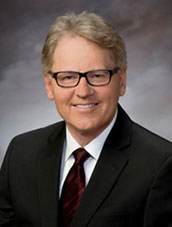
Member
Philip Davies
Philip Davies was appointed as a permanent Board Member of the NEB on 7 January 2013. His term is for a period of seven years, on a full-time basis.
Mr. Davies has over 30 years of experience in acquiring, constructing and operating energy infrastructures and facilities in North America’s oil, gas and electric power industries.
During his career, Mr. Davies has served as a member of several senior management teams - notably as Vice-President, Law and General Counsel of SaskPower; Vice-President, General Counsel and Corporate Secretary of Encana Gas Storage; and, Associate General Counsel of Encana Midstream and Marketing.
Mr. Davies earned his ICD.D certification from the Institute of Corporate Directors, University of Toronto, Rotman School of Management and he completed the Executive Development Program at the University of Western Ontario, Ivey School of Business. He is a graduate of the University of Alberta, Faculty of Law and an active member of the Law Societies of Alberta and Saskatchewan.

Member
Shane Parrish
Shane Parrish was appointed as a permanent Board Member of the NEB on 6 August 2013. His term is for a period of seven years, on a full-time basis.
Mr. Parrish brings to the National Energy Board 24 years of experience in the area of community economic development in the Northwest Territories, Nunavut, and N.E. British Columbia. Over the past 18 years, Mr. Parrish has worked in consultation, indigenous business development and negotiations in the petroleum and mining industries. As a consultant in the firm he founded in 2002, he has represented First Nations clients in negotiations with major Canadian energy producers and pipeline companies, with a focus on access and benefits agreements. Previously, Mr. Parrish was Manager of Business Development for Canadian Petroleum Engineering Inc., where he worked with First Nations, government and industry in both Canada and Latin America. He was also the CEO of the Acho Dene Koe Corporate Group, where he oversaw the growth and development of band-owned corporations and their relationships with oil and gas companies. Mr. Parrish’s experience also includes five years as an Economic Development Officer with the Government of the Northwest Territories.
Mr. Parrish has a Bachelor of Arts in Economics from the University of Calgary, and a Diploma in Social Development from the Coady International Institute - St. Francis Xavier University.

Member
Ron Wallace, Ph.D.
Dr. Ron Wallace was appointed as a permanent Board Member of the NEB on 1 November 2013. His term is for a period of seven years, on a full-time basis.
Mr. Wallace’s northern regulatory experience encompasses senior management positions with the Nunavut Resources Corporation, the Northwest Territories Water Board and AGRA Earth and Environmental (now AMEC Americas Ltd). At AGRA, he was involved in major oil and gas operations throughout the former Soviet Union and Russia where he managed major project assignments in conjunction with the World Bank.
An Alberta Emerald Award recipient (1996), Dr. Wallace served as Chairman of the Alberta Environmental Monitoring Working Group and more recently as Vice-Chairman of the subsequent Alberta Environmental Monitoring Management Board that led to the tabling of legislation in Alberta to create a new provincial environmental monitoring agency.
Dr. Wallace has held senior management positions with Petro-Canada and CanStar Oil Sands Ltd., and was President of Dominion Ecological Consulting Ltd., during which time he worked in environmental technology applications in northern Canada, Alberta, Venezuela and Ecuador. He has also participated in mediations and negotiations involving energy developers, northern Aboriginal communities and governments.
Dr. Wallace holds a Ph.D. in Aquatic Ecology and Environmental Toxicology from the University of Waterloo.
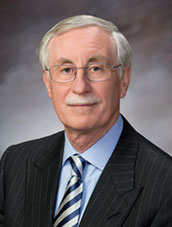
Temporary Member
Kenneth Bateman
Mr. Bateman was first appointed as a permanent Board Member of the NEB on 5 September 2006. He was reappointed to a one year term as a permanent Board Member of the NEB on 5 September 2013. As of 6 September 2014, Mr. Bateman continues to serve the Board as a Temporary Member on an ongoing hearing and other projects. Mr. Bateman is an energy lawyer, former senior executive and nationally qualified arbitrator.
Prior to appointment to the NEB, Kenneth was Vice-president and general counsel to a large Canadian utility corporation in power generation, transmission, distribution and sale of electricity. He is an expert in energy transactions, regulatory compliance and environmental law. His wide-ranging experience includes sustainable energy projects, the construction and operation of one of Canada’s largest wind farms and bio-waste remediation.
As a nationally qualified arbitrator and trained mediator, Kenneth has extensive knowledge and experience in complex multi-party disputes involving national companies, environmental organizations, Aboriginal groups, landowners and others. He serves on the Board of Directors of the Canadian Council of Administrative Tribunals and is a member of the Alternative Dispute Resolution Institute of Canada and Alberta Arbitration and Mediation Society.
Mr. Bateman has taught at various Canadian universities in International Law, Transactions, Business Management and Negotiation. He also speaks nationally and internationally, most recently in Dubai at the World Future Energy Summit (2011).
Mr. Bateman holds a law degree from the University of Alberta (1984) and Masters of International Business Management from the American Graduate School of International Management (1995).
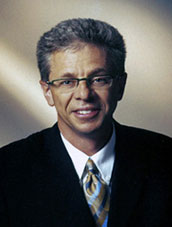
Temporary Member
David Hamilton
David Hamilton was re-appointed as Temporary Board Member for a three-year term ending 30 June 2015.
A resident of Sidney, British Columbia, Mr. Hamilton holds a Master’s degree in Leadership and Training from Royal Roads University, Victoria, British Columbia. Mr. Hamilton has more than 30 years of experience working in the Northwest Territories in the development of communities through both the parliamentary and democratic processes.
Mr. Hamilton was Deputy Minister and Clerk of the Legislative Assembly of the Northwest Territories for 20 years. He also held the appointment as Chief Electoral Officer for the Northwest Territories. Mr. Hamilton administered the first general election for Members to the Legislative Assembly in Canada’s two new Territories, Nunavut and the Northwest Territories, following division of the NWT in 1999. Mr. Hamilton participated in the ratification votes for the Gwich’in Land Claim Agreement, the Sahtu Settlement Agreement and the Inuit Land Claim Settlement.
Mr. Hamilton has been involved in the electoral process in Canada for over 30 years and has extensive experience in community development at the Territorial, Provincial and International level.

Temporary Member
Bob Vergette
Bob Vergette was appointed as a Temporary Board Member of the NEB in December 2008. As of 4 December 2014, Mr. Vergette continues to serve the Board as a Temporary Member on an ongoing hearing.
Before joining the Board, Mr. Vergette was a consultant to a South American national pipeline regulator on regulatory assurance matters. Prior to this, he was Vice President, Operations with a major North American liquids pipeline company.
Over the years Mr. Vergette has been active on many pipeline industry association initiatives including one on stress corrosion cracking. He has also been active in pipeline code committee work.
Mr. Vergette has a Bachelor’s degree in Mechanical Engineering from the University of Alberta and is a graduate of the Banff School of Advanced Management. He is a member of the Association of Professional Engineers, Geologists and Geophysicists of Alberta. Mr. Vergette has extensive experience in pipeline engineering and operations including integrity management systems. He has extensive regulatory experience.

Temporary Member
Alison Scott
Alison Scott was appointed as Temporary Board Member of the NEB for a three-year term ending 2 May 2015.
A graduate of Dalhousie Law School (LLB) and St FX University (BA Hons.), Ms. Scott retired from the Nova Scotia government in 2012. During her thirty years of public service she served in various capacities including Clerk of the Executive Counsel and Secretary to Cabinet, Deputy Minister of Energy and Intergovernmental Affairs. Prior to her time as a Deputy Minister, she was a litigator with the Nova Scotia Department of Justice, specializing in administrative law and constitutional law. While with the NS Department of Energy Ms. Scott oversaw the development of Nova Scotia’s energy research strategy and was instrumental in establishing ocean energy research institutions to further advance the development of Nova Scotia’s offshore petroleum, tidal energy and carbon capture and storage opportunities. In 2009 Ms. Scott was seconded to Environment Canada to advise the Deputy Minister in the development of Canada’s approach to climate change negotiations. She is a former member of: the federal government’s Energy Sector Sustainability Table, Petroleum Research Atlantic, the Oil and Gas Administration Advisory Council (established under the Canadian Oil and Gas Act), past chair of the Canadian Bar Association Constitutional Law and Human Rights section, a former part-time member of the faculty at Dalhousie law School, and the Attorney General’s representative on Nova Scotia Barrister’s Society Bar Council. She is currently a member of the Dalhousie Law School Alumni Association.

Temporary Member
James Ballem
James Ballem was appointed as a Temporary Board Member of the NEB for a period of three years ending 30 May 2015.
In 1983, Mr. Ballem was named the first Chair of the PEI Milk Marketing Board. He served in that capacity until 1987. At that time, he was appointed as Chair of the PEI Potato Commission and the PEI representative on the Sectorial Advisory Group on International trade, a position he held until 1989.
In 1996, Mr. Ballem was elected to the PEI Legislative Assembly and served as Chair of the Standing Committee on Agriculture, Forestry and the Environment. This committee was responsible for developing the Implementation Strategy for the “Round Table Report on Land Use”, and conducted a review of the PEI Lands Protection Act, the legislation responsible for the ownership and use of Agricultural land.
In 2000, Mr. Ballem was named Minister of Health and Social Services, a post he retained until 2003 when he was named Attorney General and Minister of Environment and Energy.
In 2004, he became Minister of Environment, Energy and Forestry. While in that portfolio he was responsible for the development of a major wind farm and the creation of the Renewable Energy Act.
In 2007, Mr. Ballem established an energy consulting business, with an emphasis on renewable energy.
Mr. Ballem graduated from the University of Prince Edward Island (PEI) in 1976 with a Degree in Business Administration. From 1976-1993, Mr. Ballem owned and operated a dairy farm in partnership with his father.

Temporary Member
Mike Richmond
Mr. Richmond was appointed as a Temporary Board Member of the NEB for a period of three years, on a part-time basis ending 31 October 2015.
Originally from Montreal, Quebec, Mr. Richmond practices law in Toronto, Ontario at McMillan LLP, where he is Co-Chair of the Energy and Power Group. As an energy lawyer, Mr. Richmond has extensive experience in electricity, renewables and utilities.
From 2001 to 2002, Mr. Richmond served the Government of Ontario as a Senior Energy Policy Advisor during the restructuring of Ontario’s electricity markets. In addition, Mr. Richmond has served on the Board of Directors of Toronto Hydro Corporation, Canada’s largest municipal electric utility, and on the Board of the Ontario Energy Association.
In recent years, he has served as a guest lecturer on energy policy at Queen’s University, and has spoken and written extensively on matters relating to energy policy and regulation.
Mr. Richmond holds a law degree from the University of Toronto and a Bachelor of Social Sciences degree from the University of Ottawa.

Temporary Member
Jacques Gauthier
Jacques Gauthier was appointed as a Temporary Board Member of the NEB for a period of three years ending 12 December 2015.
Mr. Gauthier’s most recent position before joining the Board was serving as the President and Chief Executive Officer of LVM Inc., and Senior Vice President of Dessau Inc. Throughout his career, Mr. Gauthier has contributed to the creation and development of major energy projects in Canada, the United States and Europe. In addition, he has held the position of President and CEO of one of Canada’s largest private renewable energy producers.
He has served on a wide variety of boards of directors and committees, including the Organizing Committee of the Vancouver 2010 Olympic Games, the Canadian Olympic Committee, the Quebec Wildlife Foundation, and the Prime Minister’s Advisory Committee on the Public Service. In 2010, Mr. Gauthier was the Prime Minister of Canada’s personal envoy for the official languages and president of the Advisory Committee on Official Languages for the Vancouver 2010 Olympic Games.
In 2012 Mr. Gauthier received the Quebec Mercuriades Award in recognition of excellence in Occupational Health and Safety.
Mr. Gauthier holds a Bachelor of Law degree from the Université de Sherbrooke and is a member of the Bar of the Province of Quebec.

Appendices
Appendix A: Hearing Decisions and Recommendations Issued in 2014
(as of 31 December 2014)
| Name | File Number | Company | Length | Commodity | Application Received | Hearing Days | Recommendation / Decision Released |
|---|---|---|---|---|---|---|---|
| 2015-2030 Tolls and Tariff Application | RH-001-2014 | TransCanada PipeLines Ltd. | n/a | Oil | 20 Dec 2013 | 12 days | 28 Nov 2014 |
| Integration Asset Transfer Project | GH-002-2014 | NOVA Gas Transmission Ltd. | n/a | Gas | 12 Nov 2013 | n/a | 16 Oct 2014 |
| Approval of set-aside and collection mechanisms for abandonment cost funding | MH-001-2013 | NEB-regulated Pipeline Companies | n/a | Gas/Oil | 28 Feb 2013 | 9 days | 29 May 2014 |
| North Reagan Pipeline Abandonment | MHW-001-2014 | Tailwaters Regulatory Ltd. on behalf of Glencoe Resources Ltd. (collectively, “Glencoe”) | 215 m | Oil | 18 Oct 2013 | n/a | 6 May 2014 |
| Line 9B Reversal and Line 9 Capacity Expansion Project | OH-002-2013 | Enbridge Pipelines Inc. | 639 km | Oil | 29 Nov 2012 | 7 days | 6 Mar 2014 |
| Edmonton to Hardisty Pipeline Project | OH-001-2013 | Enbridge Pipelines Inc. | 180 km | Oil | 14 Dec 2012 | 4 days | 30 Jan 2014 |
Appendix B: Hearings in Progress as of 31 December 2014
| Name | File Number | Company | Length | Commodity | Application Received | Hearing Days |
|---|---|---|---|---|---|---|
| Revised Nom Cap Allocation | OF-Tolls-Group1-T260-2013-06 01 | TMPL- Trans Mountain Pipeline ULC | n/a | Oil | 15 Oct 2013 | n/a |
| North Montney (s.52) |
OF-Fac-Gas-N081-2013-10 02 | NOVA Gas Transmission Ltd. | 305.9 km | Gas | 8 Nov 2013 | 17 days |
| Tolls New Services | OF-Tolls-Group1-A159-2014-01 01 | Alliance Pipeline Ltd. | n/a | Gas | 22 May 2014 | 3 days planned |
| Facilities & Expansion (TMX III) |
OF-Fac-Oil-T260-2013-03 02 | TMPL - Trans Mountain Expansion | 987 km | Oil | 16 Dec 2013 | 23 days |
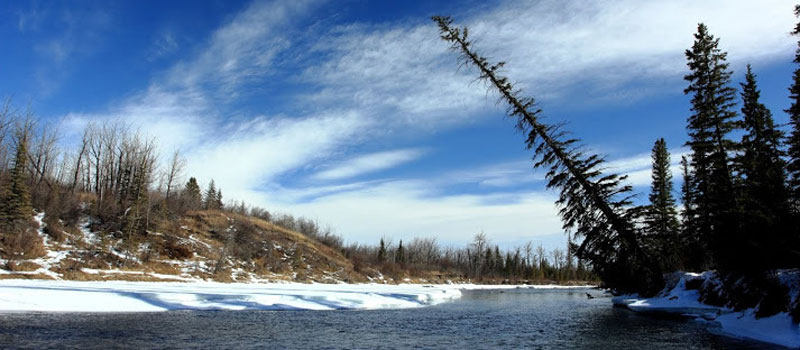
Appendix C - Court Challenges to Board or GiC Decisions in 2014
The following is a summary of challenges to Board decisions in 2014.
Geophysical Services Incorporated (GSI)
Geophysical Services Incorporated (Lynx Canada Information Systems Ltd.)
In June 2009, GSI took legal action against Lynx Canada Information Systems Ltd. (Lynx) in the Alberta Court of Queen’s Bench for copyright infringement relating to geophysical information and related relief. On 27 May 2011, Lynx brought a Third Party Claim against the National Energy Board. On 4 June 2013, GSI filed an Amended Statement of Claim naming the NEB directly as a defendant for the full amount of its claim. The file is presently ongoing.
Geophysical Services Incorporated (Olympic Seismic Ltd.)
On 19 December 2012, GSI filed with the Alberta Court of Queen’s Bench a Statement of Claim naming Olympic Seismic Ltd. (Olympic) and the NEB as defendants for copyright infringement relating to geophysical information and related relief. Olympic filed a Third Party claim against the NEB on 23 December 2013. The file is presently ongoing.
Geophysical Services Incorporated (Arcis Seismic Solutions Corp.)
On 6 March 2013, GSI filed with the Alberta Court of Queens’ Bench a Statement of Claim naming Arcis Seismic Solutions Corp., the NEB and others as defendants for copyright infringement relating to geophysical information and related relief. The file is presently ongoing.
Geophysical Services Incorporated (West Canadian Digital Imaging Inc.)
On 2 May 2012, GSI took legal action against West Canadian Digital Imaging Inc. (West Canadian) in the Alberta Court of Queen’s Bench for copyright infringement relating to geophysical information and related relief. On 13 March 2013, West Canadian brought a Third Party Claim against the National Energy Board. On 22 July 2013, GSI filed an Amended Statement of Claim naming the NEB directly as a defendant for the full amount of the claim. The file is presently ongoing.
Geophysical Services Incorporated (Exploration Geosciences Ltd.)
On 22 January 2014, GSI filed with the Alberta Court of Queen’s Bench a Statement of Claim naming Exploration Geosciences Ltd., the NEB and others as defendants for copyright infringement relating to geophysical information and related relief. GSI filed an Amended Statement of Claim on 6 May 2014. The file is presently ongoing.
Geophysical Services Incorporated (Franklin Petroleum Limited)
On 5 March 2014, GSI filed with the Alberta Court of Queen’s Bench a Statement of Claim naming Franklin Petroleum Limited and the NEB as defendants for copyright infringement relating to geophysical information and related relief. GSI filed a Notice of Discontinuance on 15 August 2014.
Geophysical Services Incorporated (Her Majesty the Queen in Right of Canada)
On 14 May 2014, GSI filed with the Alberta Court of Queen’s Bench a Statement of Claim naming Her Majesty the Queen in Right of Canada, the NEB and others as defendants for copyright infringement relating to geophysical information and related relief. The file is presently ongoing.
Enbridge Line 9B Reversal and Line 9 Capacity Expansion Project
ForestEthics Advocacy Association and Donna Sinclair
On 12 August 2013, Forest Ethics Advocacy Association (ForestEthics) and Donna Sinclair filed with the Federal Court of Appeal a Notice of Application for Judicial Review regarding the NEB’s consideration of Enbridge Pipelines Inc.’s application for the Line 9B Reversal and Line 9 Capacity Expansion Project. ForestEthics and Donna Sinclair sought a declaration that s.55.2 of the NEB Act is unconstitutional under s.2(b) of the Charter; an order quashing the NEB’s decisions regarding standing; an order that the NEB accept all letters of comment from groups and individuals who seek to participate; and related relief. The Court dismissed the Application for Judicial Review on 31 October 2014.
Chippewas of the Thames First Nation
On 7 April 2014, the Chippewas of the Thames First Nation filed with the Federal Court of Appeal a Notice of Motion for Leave to Appeal the NEB Reasons for Decision for the Line 9B Reversal and Line 9 Capacity Expansion Project issued on 6 March 2014. The Court granted the Motion for Leave to Appeal on 4 June 2014. The Chippewas of the Thames First Nation filed their Notice of Appeal on 1 August 2014. The file is presently ongoing.
Northern Gateway Project
Federation of British Columbia Naturalists (BC Nature)
On 17 January 2014, BC Nature filed with the Federal Court of Appeal a Notice of Application for Judicial Review in respect of the Joint Review Panel Report for the Enbridge Northern Gateway Project issued on 19 December 2013. The file is presently ongoing.
On 14 July 2014, BC Nature filed with the Federal Court of Appeal a Notice of Motion for Leave to Seek Judicial Review of the Order of the Governor in Council of 17 June 2014 regarding the Enbridge Northern Gateway Project. The Federal Court of Appeal granted the Leave to Apply for Judicial Review on 26 September 2014. On 3 October 2014, BC Nature filed with the Federal Court of Appeal a Notice of Application for Judicial Review of the Order of the Governor in Council. The file is presently ongoing.
ForestEthics Advocacy Association, Living Oceans Society and Raincoast Conservation Foundation (ForestEthics)
On 17 January 2014, ForesEthics filed with the Federal Court of Appeal a Notice of Application for Judicial Review in respect of the Joint Review Panel Report for the Enbridge Northern Gateway Project issued on 19 December 2013. The file is presently ongoing.
On 11 July 2014, ForestEthics filed with the Federal Court of Appeal a Notice of Motion for Leave to Seek Judicial Review of the Order of the Governor in Council of 17 June 2014 regarding the Enbridge Northern Gateway Project. The Federal Court of Appeal granted the Leave to Apply for Judicial Review on 26 September 2014. On 3 October 2014, ForestEthics filed with the Federal Court of Appeal a Notice of Application for Judicial Review of the Order of the Governor in Council. The file is presently ongoing.
On 10 July 2014, ForestEthics filed with the Federal Court of Appeal a Notice of Motion for Leave to Appeal the Certificates of Public Convenience and Necessity issued by the NEB on 18 June 2014 in respect of the Enbridge Northern Gateway Project. The Court granted the Leave to Appeal on 26 September 2014. ForestEthics filed their Notice of Appeal on 25 November 2015. The file is presently ongoing.
Gitga’at First Nation
On 17 January 2014, Gitga’at First Nation filed with the Federal Court of Appeal a Notice of Application for Judicial Review in respect of the Joint Review Panel Report for the Enbridge Northern Gateway Project issued on 19 December 2013. The file is presently ongoing.
On 14 July 2014, Gitga’at First Nation filed with the Federal Court of Appeal a Notice of Motion for Leave to Seek Judicial Review of the Order of the Governor in Council of 17 June 2014 regarding the Enbridge Northern Gateway Project. The Federal Court of Appeal granted the Leave to Apply for Judicial Review on 26 September 2014. On 3 October 2014, Gitga’at First Nation filed with the Federal Court of Appeal a Notice of Application for Judicial Review of the Order of the Governor in Council. The file is presently ongoing.
Gitxaala Nation
On 17 January 2014, Gitxaala Nation filed with the Federal Court of Appeal a Notice of Application for Judicial Review in respect of the Joint Review Panel Report for the Enbridge Northern Gateway Project issued on 19 December 2013. The file is presently ongoing.
On 11 July 2014, Gitxaala Nation filed with the Federal Court of Appeal a Notice of Motion for Leave to Seek Judicial Review of the Order of the Governor in Council of 17 June 2014 regarding the Enbridge Northern Gateway Project. The Federal Court of Appeal granted the Leave to Apply for Judicial Review on 26 September 2014. On 2 October 2014, Gitxaala Nation filed with the Federal Court of Appeal a Notice of Application for Judicial Review of the Order of the Governor in Council. The file is presently ongoing.
On 16 July 2014, Gitxaala Nation filed with the Federal Court of Appeal a Notice of Motion for Leave to Appeal the Certificates of Public Convenience and Necessity issued by the NEB on 18 June 2014 in respect of the Enbridge Northern Gateway Project. The Court granted the Motion for Leave to Appeal on 26 September 2014. Gitxaala Nation filed their Notice of Appeal on 25 November 2015. The file is presently ongoing.
Council of the Haida Nation
On 14 July 2014, the Council of the Haida Nation filed with the Federal Court of Appeal a Notice of Motion for Leave to Seek Judicial Review of the Order of the Governor in Council of 17 June 2014 regarding the Enbridge Northern Gateway Project. The Federal Court of Appeal granted the Leave to Apply for Judicial Review on 26 September 2014. On 3 October 2014, the Council of the Haida Nation filed with the Federal Court of Appeal a Notice of Application for Judicial Review of the Order of the Governor in Council. The file is presently ongoing.
Haisla Nation
On 17 January 2014, Haisla Nation filed a Notice of Application for Judicial Review in respect of the Joint Review Panel Report for the Enbridge Northern Gateway Project issued on 19 December 2013. The file is presently ongoing.
On 11 July 2014, Haisla Nation filed with the Federal Court of Appeal a Notice of Motion for Leave to Seek Judicial Review of the Order of the Governor in Council of 17 June 2014 regarding the Enbridge Northern Gateway Project. The Federal Court of Appeal granted the Leave to Apply for Judicial Review on 26 September 2014. On 3 October 2014, Haisla Nation filed with the Federal Court of Appeal a Notice of Application for Judicial Review of the Order of the Governor in Council. The file is presently ongoing.
On 16 July 2014, Haisla Nation filed with the Federal Court of Appeal a Notice of Motion for Leave to Appeal the Certificates of Public Convenience and Necessity issued by the NEB on 18 June 2014 in respect of the Enbridge Northern Gateway Project. The Court granted the Motion for Leave to Appeal on 26 September 2014. Haisla Nation filed their Notice of Appeal on 25 November 2015. The file is presently ongoing.
Kitasoo Xai’Xais Band and Heiltsuk Nation (Kitasoo and Heiltsuk)
On 11 July 2014, Kitasoo and Heiltsuk filed with the Federal Court of Appeal a Notice of Motion for Leave to Seek Judicial Review of the Order of the Governor in Council of 17 June 2014 regarding the Enbridge Northern Gateway Project. The Federal Court of Appeal granted the Leave to Apply for Judicial Review on 26 September 2014. On 3 October 2014, Kitasoo and Heiltsuk filed with the Federal Court of Appeal a Notice of Application for Judicial Review of the Order of the Governor in Council. The file is presently ongoing.
Nak’azdli and Nadleh Whut’en First Nations (Nak’azdli and Nadleh Whut’en)
On 14 July 2014, Nak’azdli and Nadleh Whut’en filed with the Federal Court of Appeal a Notice of Motion for Leave to Seek Judicial Review of the Order of the Governor in Council of 17 June 2014 regarding the Enbridge Northern Gateway Project. The Federal Court of Appeal granted the Leave to Apply for Judicial Review on 26 September 2014. On 3 October 2014, Nak’azdli and Nadleh Whut’en filed with the Federal Court of Appeal a Notice of Application for Judicial Review of the Order of the Governor in Council. The file is presently ongoing.
Unifor
On 14 July 2014, Unifor filed with the Federal Court of Appeal a Notice of Motion for Leave to Seek Judicial Review of the Order of the Governor in Council of 17 June 2014 regarding the Enbridge Northern Gateway Project. The Federal Court of Appeal granted the Leave to Apply for Judicial Review on 26 September 2014. On 3 October 2014, Unifor filed with the Federal Court of Appeal a Notice of Application for Judicial Review of the Order of the Governor in Council. The file is presently ongoing.
On 16 July 2014, Unifor filed with the Federal Court of Appeal a Notice of Motion for Leave to Appeal the Certificates of Public Convenience and Necessity issued by the NEB on 18 June 2014 in respect of the Enbridge Northern Gateway Project. The Court granted the Motion for Leave to Appeal on 26 September 2014. Unifor filed their Notice of Appeal on 25 November 2015. The file is presently ongoing.
Trans Mountain Pipeline Expansion Project
Tsleil-Waututh Nation
On 2 May 2014, the Tsleil-Waututh Nation filed with the Federal Court of Appeal a Notice of Motion for Leave to Appeal the NEB’s 2 April 2014 Hearing Order regarding the Trans Mountain Pipeline Expansion Project, and related decisions of the NEB on the same date. The Court granted the Application for Leave to Appeal on 10 July 2014. Tsleil-Waututh Nation filed its Notice of Appeal on 8 September 2014. The file is presently ongoing.
City of Vancouver
On 20 August 2014, the City of Vancouver filed with the Federal Court of Appeal a Notice of Motion for Leave to Appeal the NEB’s Hearing Order regarding the Trans Mountain Pipeline Expansion Project and the NEB’s ruling on the City of Vancouver’s request for the List of Issues for the Board’s hearing of the Trans Mountain Pipeline Expansion Project to include the environmental and socio-economic effects associated with upstream activities, the development of oil sands, or the downstream use of the oil transported by the pipeline. The Court dismissed the Application for Leave to Appeal on 16 October 2014.
L.D. Danny Harvey
On 3 September 2014, Mr. Harvey filed with the Federal Court of Appeal a Notice of Motion for Leave to Appeal the NEB’s ruling dated 19 August 2014 dismissing Mr. Harvey’s motion for a review of the NEB’s decision of 29 July 2013 which sets out the List of Issues for the Board’s hearing of the Trans Mountain Pipeline Expansion Project, a review of the Board’s ruling on participation and a review of the List of Issues. The Court dismissed the Application for Leave to Appeal on 24 October 2014.
Lynne M. Quarmby, Eric Doherty, Ruth Walmsley, John Vissers, Shirley Samples, ForesEthics Advocacy Association, Tzeporah Berman, John Clarke and Bradley Shende (Applicants)
On 29 October 2014, the Applicants filed with the Federal Court of Appeal a Notice of Motion for Leave to Appeal the 2 October 2014 standing decision of the NEB for the Trans Mountain Pipeline Expansion Project. The Applicants argued that the standing test in section 55.2 of the NEB Act or, alternatively, the Board’s application of it in the TMX hearing, violated the Charter. The file is presently ongoing.
City of Burnaby
On 8 September 2014, the City of Burnaby (Burnaby) filed a Statement of Claim with the British Columbia Supreme Court seeking injunctive relief against Trans Mountain Pipeline ULC and declarations against the NEB. The Statement of Claim raises issues involving access to Burnaby land for pipeline routing surveys. An Application for a temporary injunction against access to Burnaby land for survey purposes was dismissed by the Supreme Court of British Columbia on 17 September 2014. On 2 October 2014, Burnaby filed with the British Columbia Court of Appeal a Notice of Application for Leave to Appeal the 17 September 2014 Order of the Supreme Court of British Columbia. That application for Leave to Appeal was dismissed by the British Columbia Court of Appeal on 27 November 2014. On 4 December 2014 Burnaby made an application to the British Columbia Court of Appeal to vary the dismissal order. The file is presently ongoing.
On 30 October 2014, Burnaby filed with the Federal Court of Appeal a Notice of Motion for Leave to Appeal the 23 October 2014 ruling of the NEB on a notice of motion and Notice of Constitutional Question concerning access to lands to complete survey work for Trans Mountain’s preferred pipeline corridor. The Court dismissed the Application for Leave to Appeal on 12 December 2014.
Dr. Gary Smith, Andrée Stow, Petronella Smid, El Punnett, Laura Hansen, Paul Christensen, Karen Larson and Mathias Hennig (Applicants)
On 10 June 2014, the Applicants filed with the Federal Court a Notice of Application for Judicial Review in respect of decisions issued by the Funding Review Committee and the Chief Operating Officer of the NEB dated 7 May 2014, denying the Applicants’ request for participant funding relating to the Trans Mountain Expansion Project application. The file is presently ongoing.
Other
Council of Canadians
On 12 May 2014, the Council of Canadians filed with the Federal Court of Appeal a Notice of Motion for Leave to Appeal the 14 April 2014 decision of the NEB to issue the List of Issues for the NEB’s consideration in any upcoming proceeding with respect to the Energy East Pipeline Project proposed by Energy East Pipeline Ltd. before the filing of the Project application with the NEB. The Court dismissed the Application for Leave to Appeal on 25 July 2014.
Hamlet of Clyde River, Nammautaq Hunters & Trappers Organization - Clyde River, and Jerry Nathanine
On 28 July 2014, the Hamlet of Clyde River and others filed with the Federal Court of Appeal a Notice of Application for Judicial Review in respect of the 26 June 2014 decision of the NEB to grant a Geophysical Operations Authorization to TGS-NOPEC Geophysical Company ASA and others to conduct a 2D marine seismic survey in Baffin Bay and Davis Strait. The file is presently ongoing.
Appendix D - Oil Orders
| Applicant | Order Number | Date Issued | Description |
|---|---|---|---|
| Enbridge Pipelines Inc. | XO-E101-021-2014 | 5 December 2014 | Line 67 Upgrades at Hardisty File OF-Fac-Oil-E101-2014-14 01 |
| Enbridge Pipelines Inc. | AO-002-XO-E101-016-2014 | 25 November 2014 | Line 11 Westover Segment Replacement Project File OF-Fac-Oil-E101-2014-01 01 |
| Enbridge Pipelines Inc. | XO-E101-020 | 12 November 2014 | Husky Connection Upgrade at Hardisty Terminal Projecty File OF-Fac-Oil-E101-2014-12 01 |
| Enbridge Pipelines Inc. | AO-002-XO-E101-004-2013 | 17 October 2014 | Alberta Clipper Capacity Expansion Project File OF-Fac-Oil-E101-2012-11 03 01 |
| Enbridge Pipelines Westspur Inc. | XO-E103-019-2014 | 8 October 2014 | Manitoba Interconnect Project. The removal of existing segments plus the construction of new piping associated with Lines 23A and 23B File OF-Fac-Oil-E103-2014-01 01 |
| Trans Mountain Pipeline ULC | XO-T260-017-2014 | 3 September 2014 | McLeod River HDD Pipe Replacement Project File OF-Fac-Oil-T260-2014-04 01 |
| Enbridge Pipelines Inc. | XO-E101-016-2014 | 21 August 2014 | Line 11 Westover Segment Replacement Project File OF-Fac-Oil-E101-2014-01 01 |
| Pouce Coupé Pipe Line Ltd. | XO-P123-015-2014 | 15 August 2014 | Northern System HVP Spirit River Pump Station Addition of two 2750hp electrically driven centrifugal pumps to an existing block valve site File OF-Fac-Oil-P123-2014-02 01 |
| Enbridge Pipelines Inc. | AO-002-XO-E101-017-2013 | 7 August 2014 | Edmonton Terminal (South) Expansion Project File OF-Fac-Oil-E101-2013-05 01 |
| Enbridge Pipelines Inc. | XO-E101-014-2014 | 31 July 2014 | IPF Cold Lake West Expansion at Enbridge Edmonton Terminal File OF-Fac-Oil-E101-2014-10 01 |
| Enbridge Pipelines Inc. | AO-001-XO-E101-009-2014 | 30 July 2014 | Line 4 and 67 Transient Mitigation Project at Kerrobert Terminal File OF-Fac-Oil-E101-2014-04 01 |
| Pouce Coupé Pipe Line Ltd. | XO-P123-013-2014 | 29 July 2014 | Northern Pipeline Diversion Project File OF-Fac-Oil-P123-2014-01 01 |
| Enbridge Pipelines Inc. | XO-E101-012-2014 | 18 July 2014 | Line 4 Relief Line to Tank 40 at Hardisty File OF-Fac-Oil-E101-2014-09 01 |
| Trans Mountain Pipeline ULC | XO-T260-011-2014 | 10 July 2014 | Edmonton Terminal Additional Pumps, Piping and Facilities Project File OF-Fac-Oil-T260-2014-03 01 |
| Enbridge Pipelines Inc. | AO-001-XO-E101-014-2013 | 12 June 2014 | Eastern Access Edmonton Terminal Connectivity Phase 2 File OF-Fac-Oil-E101-2013-08 01 |
| Kinder Morgan Cochin ULC | AO-001-K077-015-2013 | 2 June 2014 | Cochin Pipeline System Reversal Project File OF-Fac-Oil-K077-2012-01 01 |
| Enbridge Pipelines Inc. | AO-001-XO-E101-011-2013 | 30 May 2014 | Eastern Access Edmonton Satellite Booster Pump and Manifold 203 Project File OF-Fac-Oil-E101-2013-07 01 |
| Enbridge Pipelines Inc. | AO-001-XO-E101-004-2014 | 22 May 2014 | Cromer Terminal Booster Pump Addition File OF-Fac-Oil-E101-2013-20 02 |
| Enbridge Pipelines Inc. | XO-E101-010-2014 | 13 May 2014 | Line 67 Upgrades at Hardisty Terminal File OF-Fac-Oil-E101-2014-05 01 |
| Enbridge Pipelines Inc. | XO-E101-009-2014 | 12 May 2014 | Line 4 and 67 Transient Mitigation Project at Kerrobert Terminal File OF-Fac-Oil-E101-2014-04 01 |
| Trans Mountain Pipeline ULC | AO-001-XO-T260-009-2013 | 8 May 2014 | Nipisi Facility Piping File OF-Fac-Oil-T260-2013-01 01 |
| TransCanada Keystone Pipeline GP Ltd. | XO-T241-007-2014 | 11 April 2014 | Husky East Campus Interconnect Project File : OF-Fac-Oil-T241-2014-01 01 |
| Enbridge Pipelines Inc. | AO-001-XO-E101-021-2013 | 7 April 2014 | Plains Wascana Tank 80 Project at Regina Terminal File OF-Fac-Oil-E101-2013-12 02 |
| Enbridge Pipelines Inc. | AO-001-XO-E101-017-2013 | 4 April 2014 | Edmonton Terminal (South) Expansion Project File OF-Fac-Oil-E101-2013-05 01 |
| Enbridge Pipelines Inc. | XO-E101-004-2014 | 26 February 2014 | Cromer Terminal Booster Pump Addition File OF-Fac-Oil-E101-2013-20 01 |
| Enbridge Pipelines Inc. | XO-E101-002-2014 | 10 February 2014 | Alberta Clipper Capacity Expansion Project Phase II File OF-Fac-Oil-E101-2013-19-01 |
| Enbridge Pipelines Inc. | XO-E101-001-2014 | 24 January 2014 | Keyera Diluent Connection at Edmonton Terminal Project File OF-Fac-Oil-E101-2013-18 01 |
Appendix E - Gas Orders
| Applicant | Order Number | Date Issued | Description |
|---|---|---|---|
| NOVA Gas Transmission Ltd. | XG-N081-023-2014 | 17 December 2014 | Alder Flats South No. 2 Receipt Meter Station File OF-Fac-Gas-N081-2014-1201 |
| NOVA Gas Transmission Ltd. | XG-N081-022-2014 | 9 December 2014 | Wildhay River South Receipt Meter Station Project File OF-Fac-Gas-N081-2014-13 01 |
| Many Islands Pipe Lines (Canada) Ltd. | AO-001-XG-15-90 | 3 November 2014 | Application for Variance of Order XG-15-90 File OF-Fac-Gas-M182-2014-02 01 |
| NOVA Gas Transmission Ltd. | AO-01-XG-N081-018-2014 | 30 September 2014 | East Calgary B Interconnect Project File OF-Fac-Gas-N081-2014-09 01 |
| NOVA Gas Transmission Ltd. | XG-N081-021-2014 | 22 September 2014 | Carmon Creek East Sales Meter Station Project File OF-Fac-Gas-N081-2014-07 01 |
| Alliance Pipeline Ltd. (Alliance) | XG-A159-020-2014 | 9 September 2014 | Elmworth Lateral Pipe Replacement Project File OF-Fac-Gas-A159-2014-01-01 |
| NOVA Gas Transmission Ltd. | XG-N081-018-2014 | 5 September 2014 | Musreau Cutbank Expansion Project File OF-Fac-Gas-N081-2014-03 01 |
| NOVA Gas Transmission Ltd. | XG-N081-019-2014 | 5 September 2014 | Snipe Hills Compressor Station Project File OF-Fac-Gas-N081-2014-04 01 |
| NOVA Gas Transmission Ltd. | XG-N081-018-2014 | 3 September 2014 | East Calgary B Interconnect - East Calgary Receipt Meter Station File OF-Fac-Gas-N081-09 01 |
| Trans Québec and Maritimes Pipeline Inc. | XG-T201-017-2014 | 6 August 2014 | NPS 6 Saint-Jérôme Lateral Relocation Project File OF-Fac-Gas-T201-2014-02 0101 |
| Minell Pipeline Ltd. (Minell) | XG-M234-014-2014 | 25 July 2014 | Remplacement et modification du tracé d’un tronçon du gazoduc Minell à Beaver Creek près de Saint-Lazare, au Manitoba File OF-Fac-Gas-M234-2013-01-01 |
| NOVA Gas Transmission Ltd. | XG-N081-015-2014 | 25 July 2014 | Bilbo Receipt Meter Station File OF-Fac-Gas-N081-2014-02 01 |
| NOVA Gas Transmission Ltd. | XG-N081-012-2014 | 15 July 2014 | Kettle River North #2 Sales Meter Station Upgrade Project File OF-Fac-Gas-N081-2014-08 01 |
| Alliance Pipeline Ltd. (Alliance) | XG-A159-011-2014 | 14 July 2014 | Thermo-Electric Generator Installation at West Doe Meter Station Project File OF-Fac-Gas-A159-2014-02 01 |
| Trans Québec and Maritimes Pipeline Inc. | AO-001-XG-T201-009-2014 | 26 June 2014 | Lachenaie Receipt Meter Station Project File OF-Fac-Gas-T201-2014-01 01 |
| NOVA Gas Transmission Ltd. | AO-001-XG-N081-013-2013 | 24 June 2014 | Sunday Creek South Lateral Loop No. 3 File OF-Fac-Gas-N081-2013-03 01 |
| NOVA Gas Transmission Ltd. | AO-001-XG-N081-021-2013 | 28 April 2014 | Musreau Lake West Receipt Meter Station File OF-Fac-Gas-N081-2013-13 01 |
| Trans Québec and Maritimes Pipeline Inc. | XG-T201-009-2014 | 22 April 2014 | Lachenaie Receipt Meter Station Project File OF-Fac-T201-2014-01 01 |
| NOVA Gas Transmission Ltd. | XG-N081-007-2014 | 1 April 2014 | Otter Lake Compressor Station Project File OF-Fac-Gas-N081-2013-19-01 |
| Williston Hunter Canada, Inc. | XG-W155-006-2014 | 21 March 2014 | Gas Gathering Pipeline File OF-Fac-Gas-W155-2013-01 01 |
| Spectra Energy Transmission (Westcoast) | XG-W102-005-2014 | 20 March 2014 | Grizzly Sales Gas Pipeline Replacement Project File OF-Fac-Gas-W102-2014-01 01 |
| Enbridge Pipelines Inc. | XG-E101-004-2014 | 18 March 2014 | Regina Terminal Tank 73 Relief Line Connection File OF-Fac-Oil-E101-2014-02 01 |
| Spectra Energy Transmission (Westcoast) | XG-W102-003-2014 | 25 February 2014 | Chilliwack Mainline Pipeline Replacement Project (Project) File OF-Fac-Gas-W102-2013-05 01 |
| NOVA Gas Transmission Ltd. | AO-002-XG-N081-016-2012 | 19 February 2014 | Hangingstone Sales Meter Station File OF-Fac-N081-2012-10 02 |
| 1057533 Alberta Ltd. | XG-Z027-002-2014 | 7 February 2014 | Gething Source Water Pipeline Tie-In File OF-Fac-OtherComm-Z027-2013-01 01 |
| NOVA Gas Transmission Ltd. | XG-N081-001-2014 | 31 January 2014 | Resthaven Receipt Meter Station Upgrade Project File OF-Fac-Gas-N081-2013-16 01 |
| Applicant | Order Number | Date Issued | Description |
|---|---|---|---|
| NOVA Gas Transmission Ltd. | XG-N081-010-2014 | 19 June 2014 | Medicine Hat Capacity Expansion Project File OF-Fac-Gas-N081-2014-01 01 |
Appendix F - Financial Statements
The Board is funded by Parliament through the Appropriations Act, with approximately 90 per cent of its costs recovered by the Federal government from the companies whose energy facilities are regulated by the Board. Financial statements for cost recovery purposes are prepared annually and audited by the Office of the Auditor General. Table 20 provides an overview of NEB financial and human resources.
| Fiscal Year (1 April to 31 March) |
Expenditures (Million $) |
Staff (Full-Time Equivalents) |
|---|---|---|
| 2012-2013 | 69.6 | 398.1 |
| 2013-2014 | 81.7 | 425.3 |
| 2014-2015 | 84.7 | 423.6 |
Appendix G - Strategic Plan
Purpose
We regulate pipelines, energy development and trade in the Canadian public interestFootnote 6.
Vision
The NEB is active and effective in Canada’s pursuit of a sustainable energy future.
Goals
- NEB-regulated facilities and activities are safe and secure.
- The environment is protected throughout the lifecycle of NEB-regulated facilities and activities.
- Canadians benefit from efficient energy infrastructure and markets.
- The rights and interests of those affected by NEB-regulated facilities and activities are respected.
Values
Integrity: We are fair, transparent, and respectful.
Regulatory Leadership: We are responsive, proactive and innovative.
Accountability: We are accountable and support each other to deliver timely, high quality results.
Strategies
- We engage Canadians.
- We hold those we regulate accountable for results in the public interest.

- Date modified:
